Category: Visual Arts
3
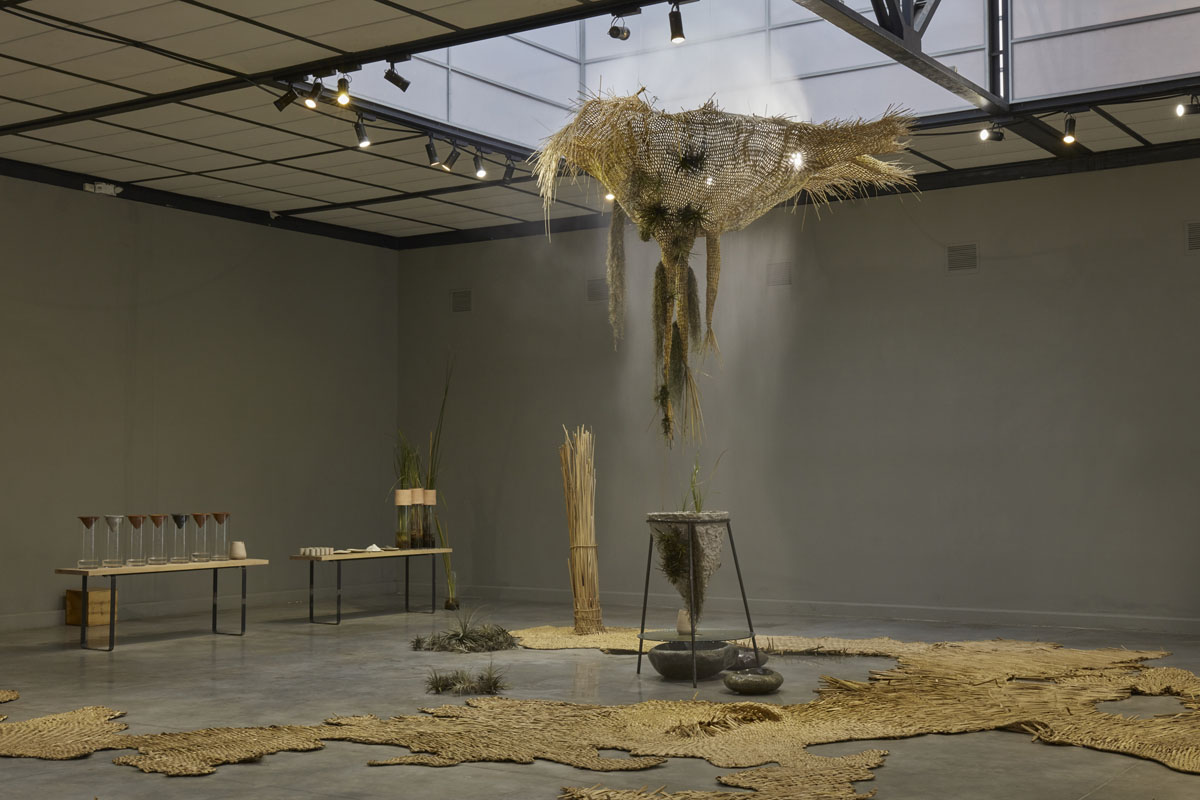
SUSTAINABLE ART: Water Ecosystem
Ana Teresa Barboza and Rafael Freyre seek to restore the symbolic value of water with and installation that combines art, design and crafts, based on an investigation of peruvian wetlands and traditional technologies for water treatment.
The societies that have inhabited the Peruvian desert have been obliged to establish a relationship with water given its scarcity. This allowed them to understand the water ecosystem and to develop technologies for the appropriate management of this valuable resource. In this way, they could inhabit arid terrestrial spaces, making them urban spaces and agricultural lands.
Throughout the pre-Columbian period, local cultures developed various systems of irrigation, capture and purification of water, such as puquios, pits, cultivation terraces and filtering galleries. A system that has drawn our attention, amongst the many, was the wachaque, a canal system that was used in the desert to plant and extract the totora and reed plants. These fibres grow naturally in the coast’s wetlands and serve to make utensils, furniture and architectural elements such as shicras. In addition, they have also been useful to purify water. Totora and reed are phytodepuration plants that contain rhizomes that grow parallel to the soil’s surface and absorb organic matter from the water.
The Project Water Ecosystem is an installation designed for the visitor to recognize this system and its processes, which involve the collection and purification of water, considering first and foremost the vegetable species which already fulfil these functions: the air plants, like the tillandsias, which capture the humidity of foggy areas and the water plants that inhabit the wetlands, such as totora and reed (junco), and the cleaning of their waters through their stems and roots. In this way, the installation integrates natural elements with ancestral and contemporary technologies of water management, with the intention of recovering this knowledge and projecting towards new practices in the future.
We are interested in recovering the relationship with the ecosystems of our territory, understanding their interactions and transformations. Likewise, we seek to create a ritual space with water, to restore its symbolic value within our communities and daily life. Water moves, flows and evaporates, changes constantly, like us. Through it, we can reflect and understand the cycles and transformations that we inhabit.
Ana Teresa Barboza
Rafael Freyre
“Ecosistema del agua” (Water Ecosystem) is the winning project of MAC LIMA National Prize Art and Innovation 2019. The museum called for artists and peruvian creators with proposals that innovate establishing relations between art, science and technology. The open call invited interdisciplinary projects that responded to technology in a wide sense: from recovery and appropriation of practices or traditional techniques, up till new media, and that take over contemporary society challenges with an artistic and critical vision.
After an exhaustive selection from the jury consisting of Natalija Boljsakov (Perú), Inti Guerrero (Colombia), Francesco Mariotti (Suiza) y Sanjay Sarma (India), MAC Lima choose Ecosistema del agua as the winning project. Moreover, there were two honorary mentions: Isla de Huacos by Camilo Nunas Ángeles Manga and Lorena Jiménez Lira, and Recirculación del flujo by Genietta Varsi, Nicola Varsi Lari and Gustavo Lari Rincón.
MAC LIMA National Prize Art and Innovation is an effort of the museum to contribute to the development of local contemporary art, with the support of Universidad de Ingeniería y Tecnología (UTEC) and under the sponsorship of BBVA Foundation of Lima.
PROJECT CONCEPT
ANA TERESA BARBOZA
RAFAEL FREYRE
COLLABORATING ARTISTS
STONEWORK
ROBERTO ROMÁN
TOTORA AND REED WEAVING
SAMUEL GOICOCHEA, EBER GOICOCHEA Y DAVID GOICOCHEA
CERAMIC WORK
ELIZABETH VÁSQUEZ
ADOBE
ERICK MALÁSQUEZ
TECHNICAL TEAM
PRODUCTION AND DESIGN DEVELOPMENT
ARQ. JAVIER RUBIO
PRODUCTION AND GENERAL MANAGEMENT
MARÍ RETAMOZO
COMMUNICATION
CLAUDIA MARTORELLET
VARIABLE FREQUENCY MOTOR SYSTEM
ING. LUIS ÁNGEL QUIJADA
VAPORIZATION SYSTEM INSTALLATION
HENRRY ALVARADO
LANDSCAPING ASSISTANCE
JONATHAN BEDOYA
HYDRAULICS SYSTEM DEVELOPMENT ASSISTANCE
ING. MANUEL MENDIETA
ING. FRANCISCO GUERRERO
PHOTOGRAPHY
ANA TERESA BARBOZA
RAFAEL FREYRE
JUAN PABLO MURRUGARA

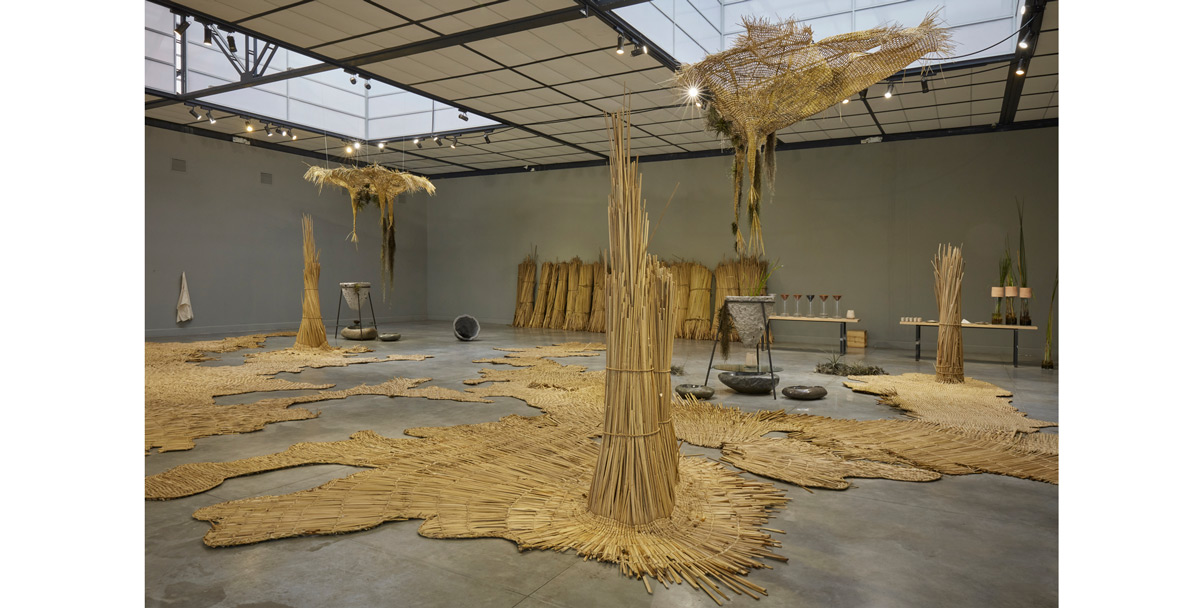
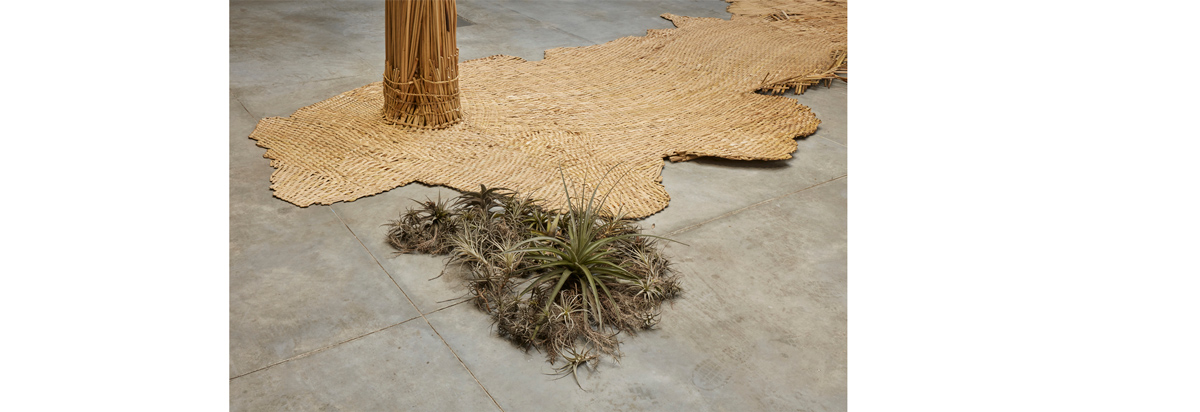
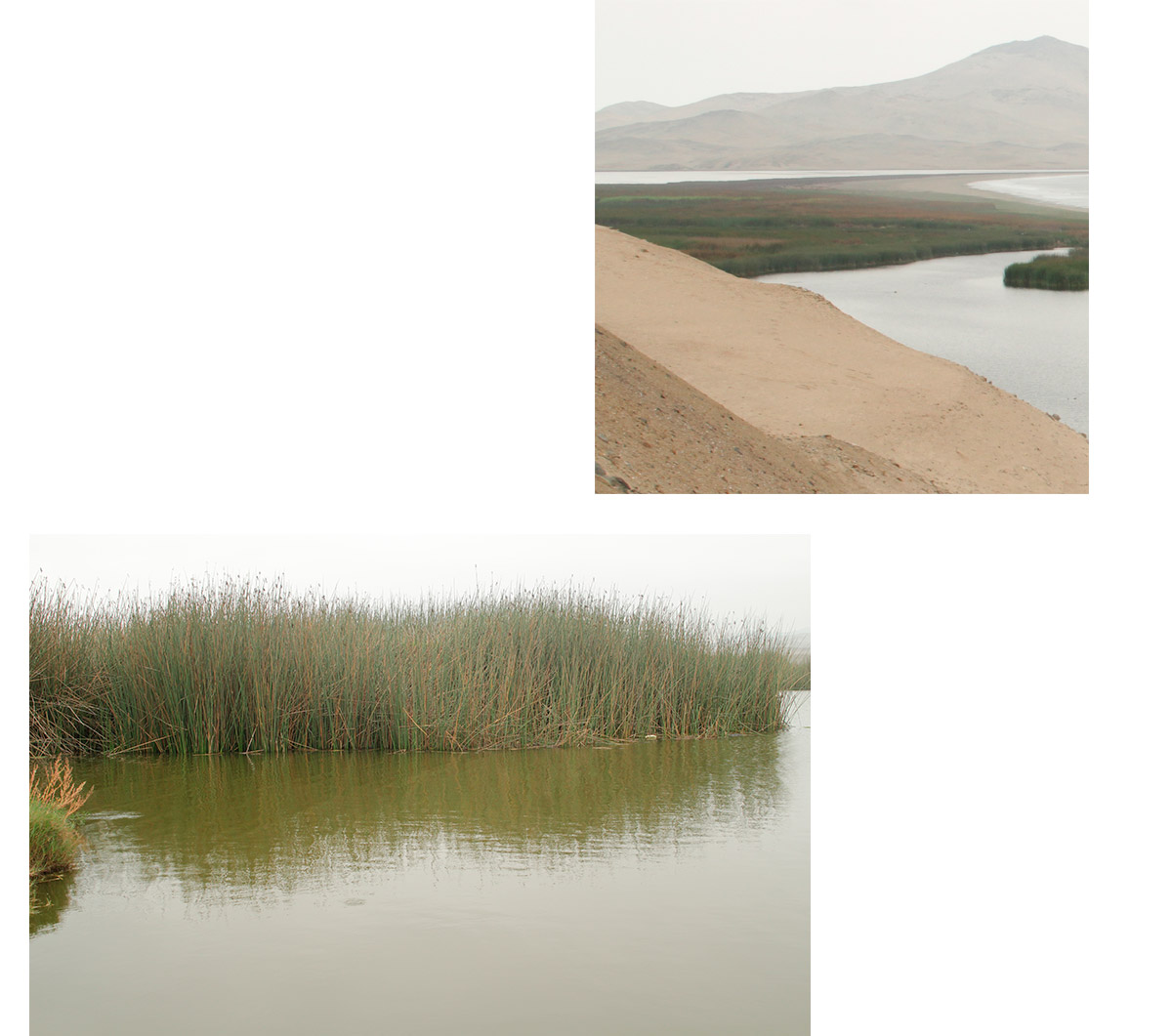
Paisajes del desierto. Desert landscapes.
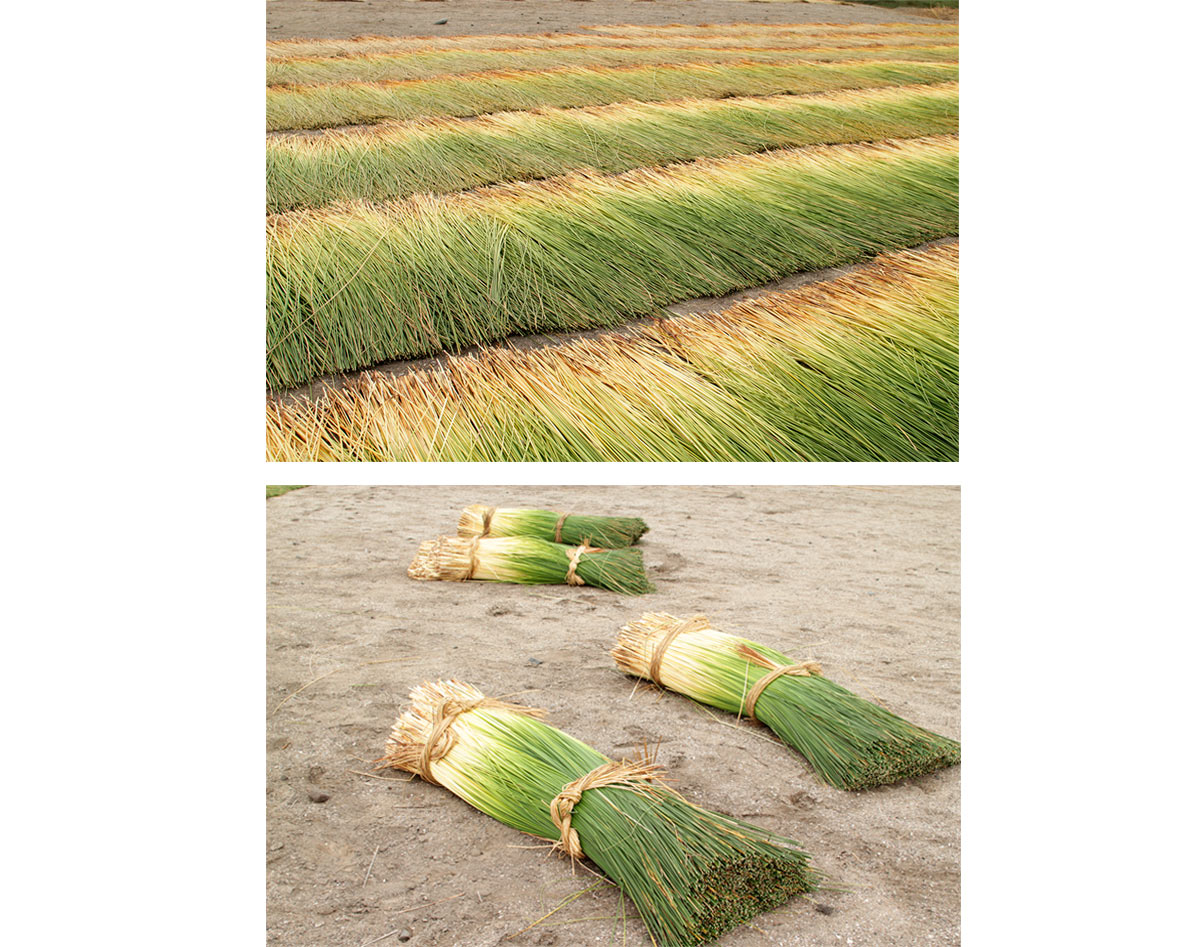
Junco de Albufera de Medio Mundo al norte de Lima. Reed from Albufera de Medio Mundo, a wetland in the central coast of Peru.
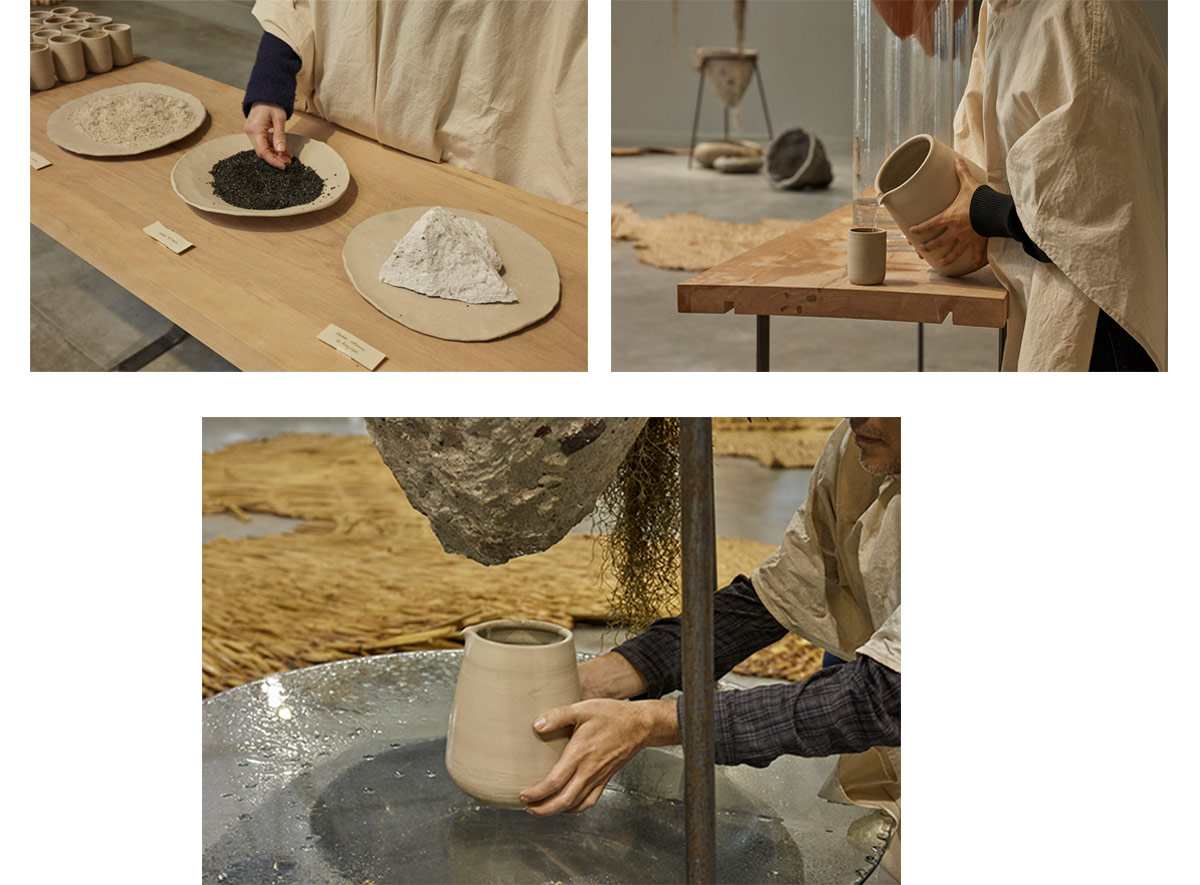
Arena de cuarzo - Carbón activado - Sillar. Quartz sand - Activated carbon - Sillar stone.
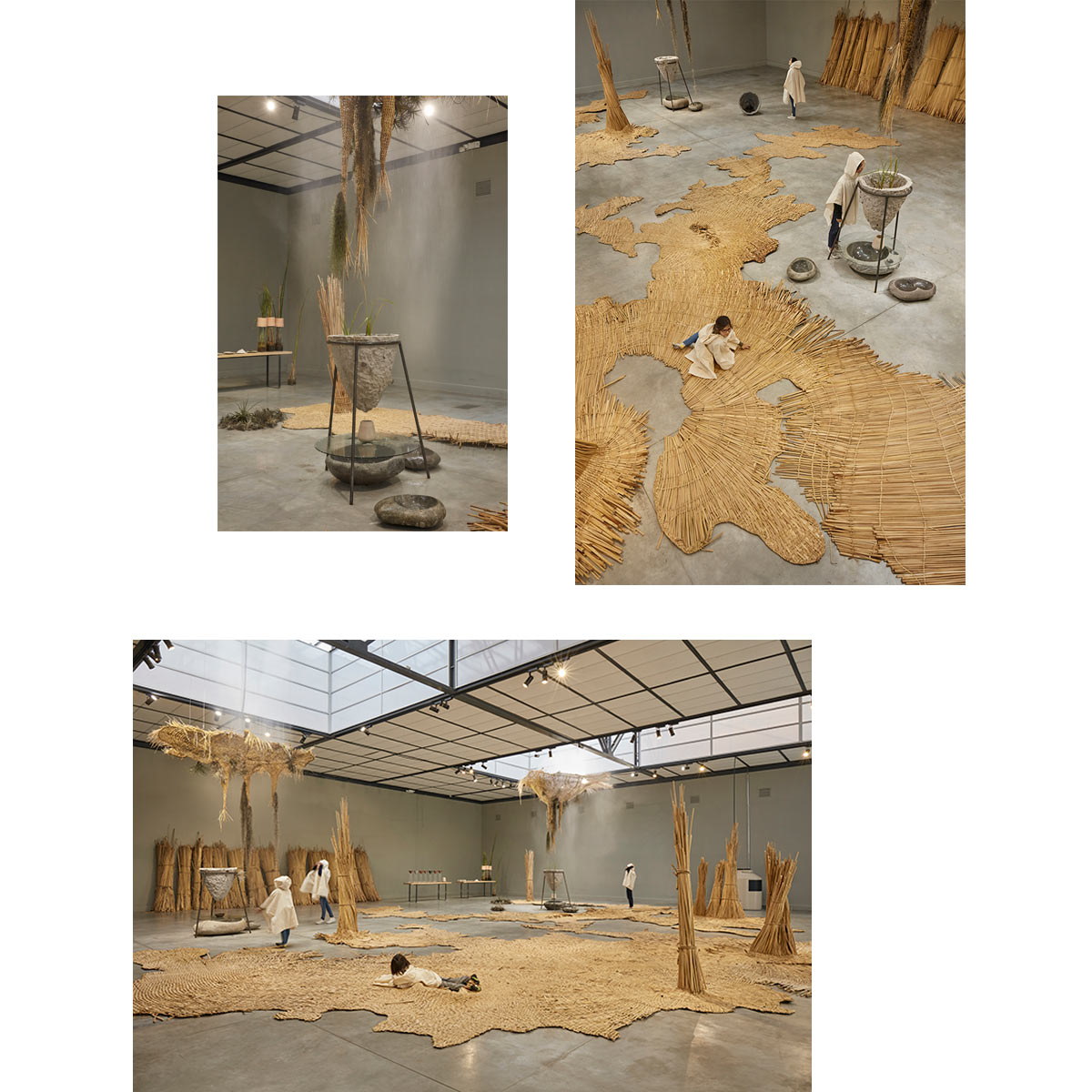
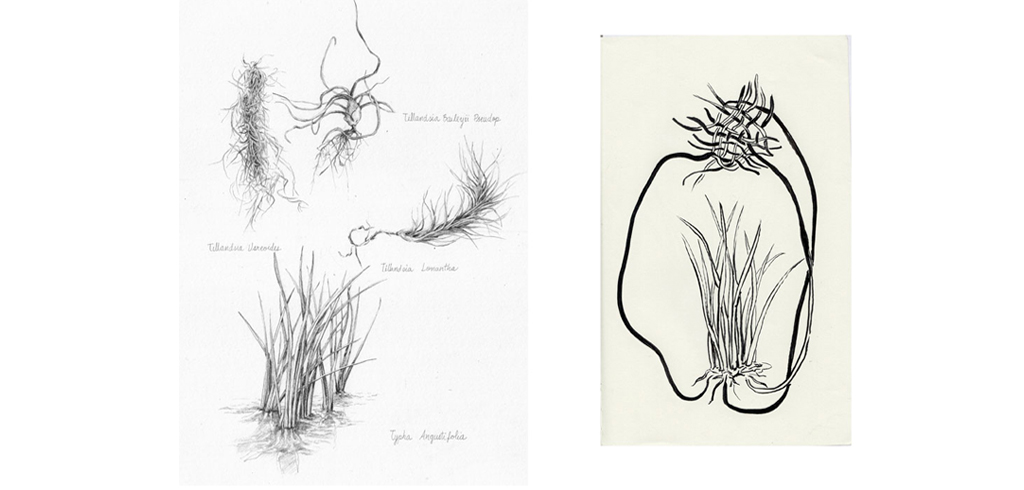
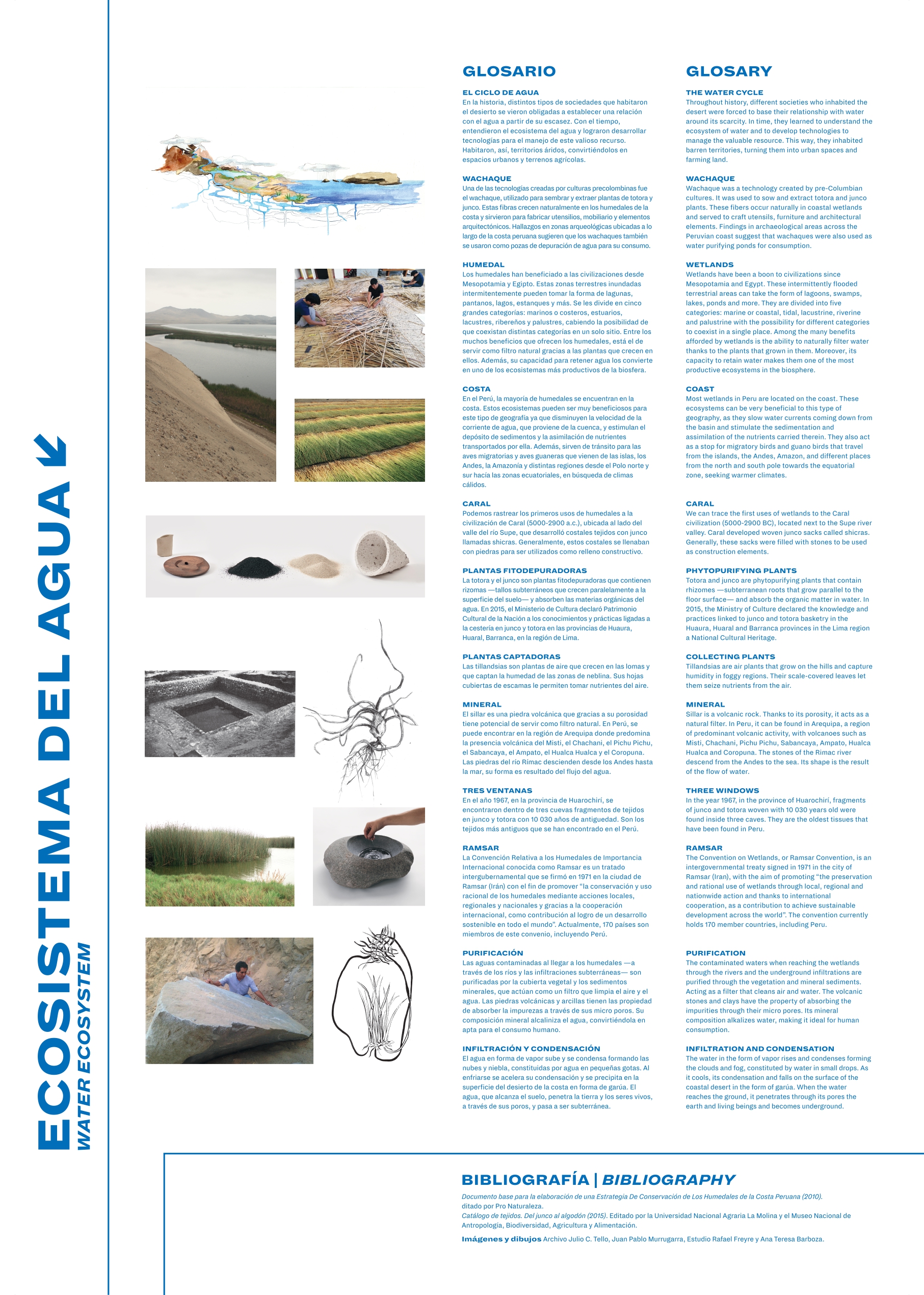

Water Ecosystem: Activities.
The activities surrounding the exhibition “Water Ecosystem” revolved around one question: How can we apply knowledge of the natural world into art? And, how can the coastal landscape, water sources and management and vegetable fibers from the wetlands be incorporated into art, design and architecture projects in a sustainable manner?
Guided visit
Ana Teresa Barboza and Rafael Freyre hosted a guided visit where they shared the reflections and insights gained during the installation assembly process, as well as answering questions from the assistants. Barboza and Freyre’s first collaborative work was 2017’s Destejer la Imagen (Unweave the Image), a series of pieces made from natural fibers and local rock types. Together, they have since explored the relationship between body and ecosystem, driven by a common interest in natural materials, artisanal traditions and the history that forms in each place. This way, they developed a particular interest in the wetlands and the link between pre-Hispanic civilizations and the coastal ecosystems of Peru.
Water sources: Technologies for water care and filtering
A panel discussion by Marino Morikawa, an environmentalist and scientist, and Arturo Alfaro, activist and director for NGO VIDA, about the issues affecting the wetlands and other natural water sources in Peru. Marino is a specialist in wetland and lake recovery by means of bio- and nanotechnologies. Arturo is dedicated to the betterment of public health conditions and is the national coordinator for the international Coastal and River Cleanup Campaign.
Junco and totora basketry laboratory
The Goicochea brothers hosted a junco and totora basketry workshop. Samuel, Ever and David are the collaborating artists behind the woven junco and totora pieces in “Water Ecosystem”. The family tradition was passed on to them by their parents, who were traditional matara and junco weavers from Cajamarca. Presently, the whole family shares a workshop in Lima where they work both together and independently.
Junco and totora designs
An exhibition and discussion featuring researcher Samuel Charca, designers Ricardo Geldrés and Alvaro Chang-Say and artist Juan Pacheco about weaving with vegetable fibers and their possible uses with contemporary technologies.
Samuel Charca is at present researching the use of natural fibers to reinforce compound laminate materials. The common thread in the works of Ricardo Geldres, Alvaro Chang Say and Juan Pacheco is their exploration of local materials and worldviews. Alvaro’s work is based around the recycling of non-conventional materials. Other than the promotion of recycling, Ricardo aims to recover artisanal techniques or the use of low technology. Juan boasts a long trajectory in weaving. He invented the Peruvian knit in 1992, and has gone on to knit fibers, metals and LED hoses since. He describes his work as neoancestral, as it seeks to transform works found in archeology into contemporary art pieces.
The panel discussion included a three-week exhibition showcasing pieces by Ricardo, Álvaro, Juan, Ana and Rafael.
Scenic Landscapes
The LOT Association for Theater Research (La Otra Orilla – The Other Shore) presented a panel discussion and performance titled Paisajes Escénicos (Scenic Landscapes). Led by Carlos Cueva and a group of artists from varied backgrounds, LOT explores the relationship between body, space and the arts. Since its foundation in 1988, LOT has produced theater plays and publications, as well as generating teaching spaces that follow in the legacy of the art vanguards. The panel discussion featured a review of experiences from LOT’s portfolio based on reflections about the landscape. Among them is Urban Landscapes, LOT’s first project to approach the subject of desert and water scarcity in the coast of Peru. The project sparked the research efforts that led to the exhibition Water Ecosystem.
Another feature was the participation of anthropologist and researcher Mijail Mitrovic, who presented the lecture “Subject, space and utopia.”
A visit to Ana and Rafael’s workshop
Finally, Ana Teresa and Rafael opened the doors to their workshop in Barranco to share their artistic processes and the references that inspire their work.
“Water Ecosystem” by Ana Teresa Barboza and Rafael Freyre is the winner project of MAC Lima’s 2019 Art and Innovation Award, sponsored by UTEC – Engineering and Technology University and BBVA Foundation Peru.
MARINO MORIKAWA
Ph.D in Bioindustrial Science, M.Sc in Agro-Bioresources Sciences and Technology (Tsukuba University, Japan).
ARTURO ALFARO
President of the NGO VIDA Institute for Environmental Protection.
SAMUEL GOICOCHEA
Artisan specialized in fabrics with vegetable fibers.
EBER GOICOCHEA
Artisan specialized in fabrics with vegetable fibers.
DAVID GOICOCHEA
Artisan specialized in fabrics with vegetable fibers.
SAMUEL CHARCA
Ph.D in Civil Engineering in the areas of materials and design (University of Puerto Rico).
RICARDO GELDRES
Bachelor of Education (San Ignacio de Loyola University). Bachelor of Arts with a major in Industrial Design (PUCP).
ALVARO CHANG SAY
Master in Design Symbolization Theories (UMSS – University of Washington), Urban Analysis (UMSS – Tulane University), Applied Peruvian Design (I.N.C). Bachelor of Education (San Ignacio de Loyola). Bachelor in Industrial Design (PUCP).
JUAN PACHECO
Bachelor of Arts (PUCP). CONCYTEC Researcher accredited by the National Registry of Researchers in Science and Technology.DINA CONCYTEC.
CARLOS CUEVA
Actor, pedagogue, director and founder of the Asociación para la Investigación Teatral La Otra Orilla (Association for Theater Research The Other Shore). Actor and founding member of Cuatro Tablas.
MIJAIL MITROVIC
Master in Social Sciences, specialty Anthropology (PUCP). Bachelor of Anthropology (PUCP).
PHOTOGRAPHY
JUAN PABLO MURRUGARA
MAC LIMA

![visitacomentada3 [:es]Ana Teresa Barboza y Rafael Freyre exponen los procesos del trabajo artístico con materiales naturales.[:] [:en]Ana Teresa Barboza and Rafael Freyre expose the processes of artistic work with natural materials.[:]](http://raffreyre.com/wp-content/uploads/visitacomentada3-1.jpg)
[:es]Ana Teresa Barboza y Rafael Freyre exponen los procesos del trabajo artístico con materiales naturales.[:] [:en]Ana Teresa Barboza and Rafael Freyre expose the processes of artistic work with natural materials.[:]
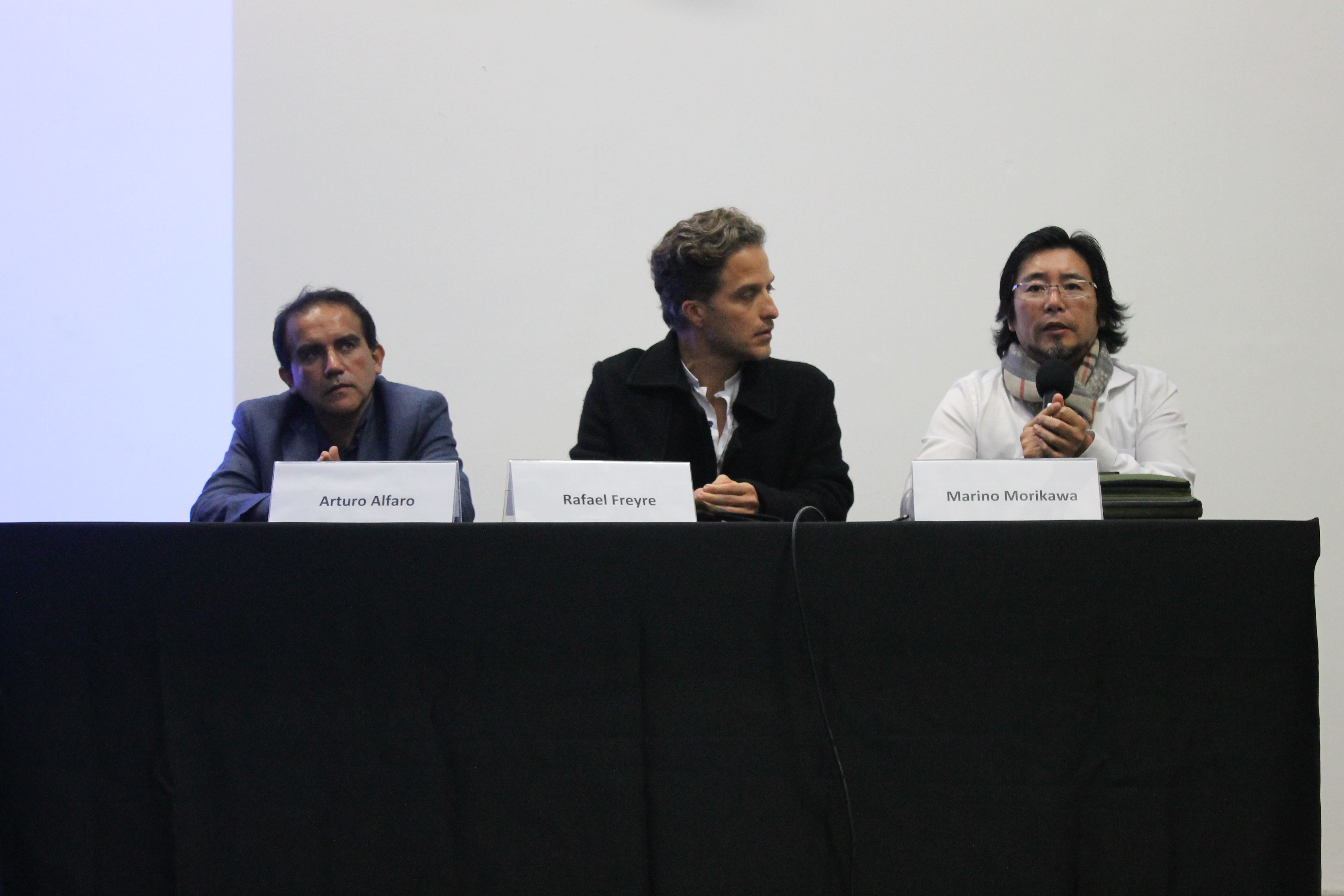
Arturo Alfaro, Rafael Freyre y Marino Morikawa conversan sobre los problemas que afectan a los humedales en el Perú. Arturo Alfaro, Rafael Freyre and Marino Morikawa discuss the problems that affect wetlands in Peru.
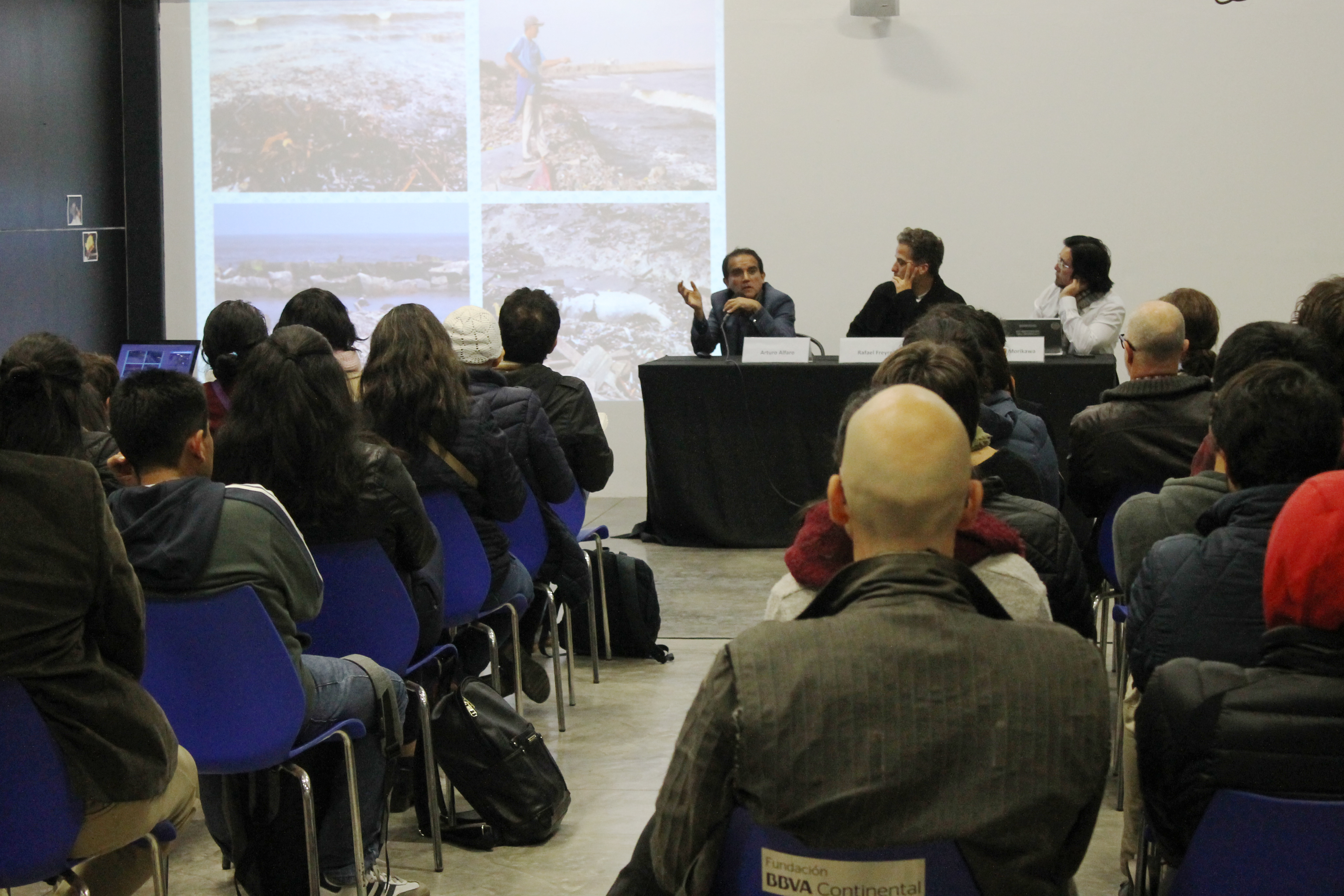
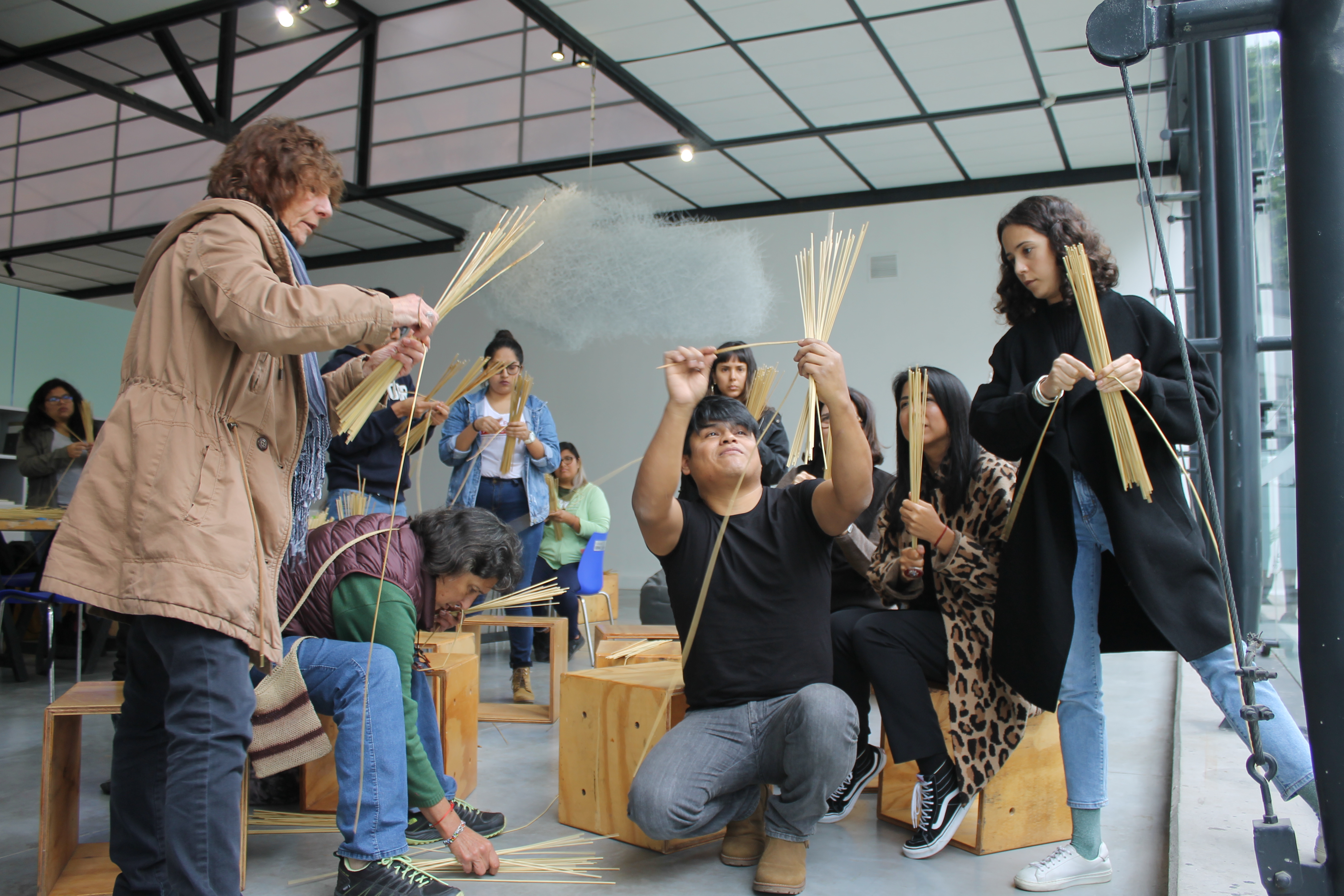
Samuel Goicochea enseña técnicas tradicionales de tejido con fibras naturales. Samuel Goicochea teaches traditional weaving techniques with natural fibers.
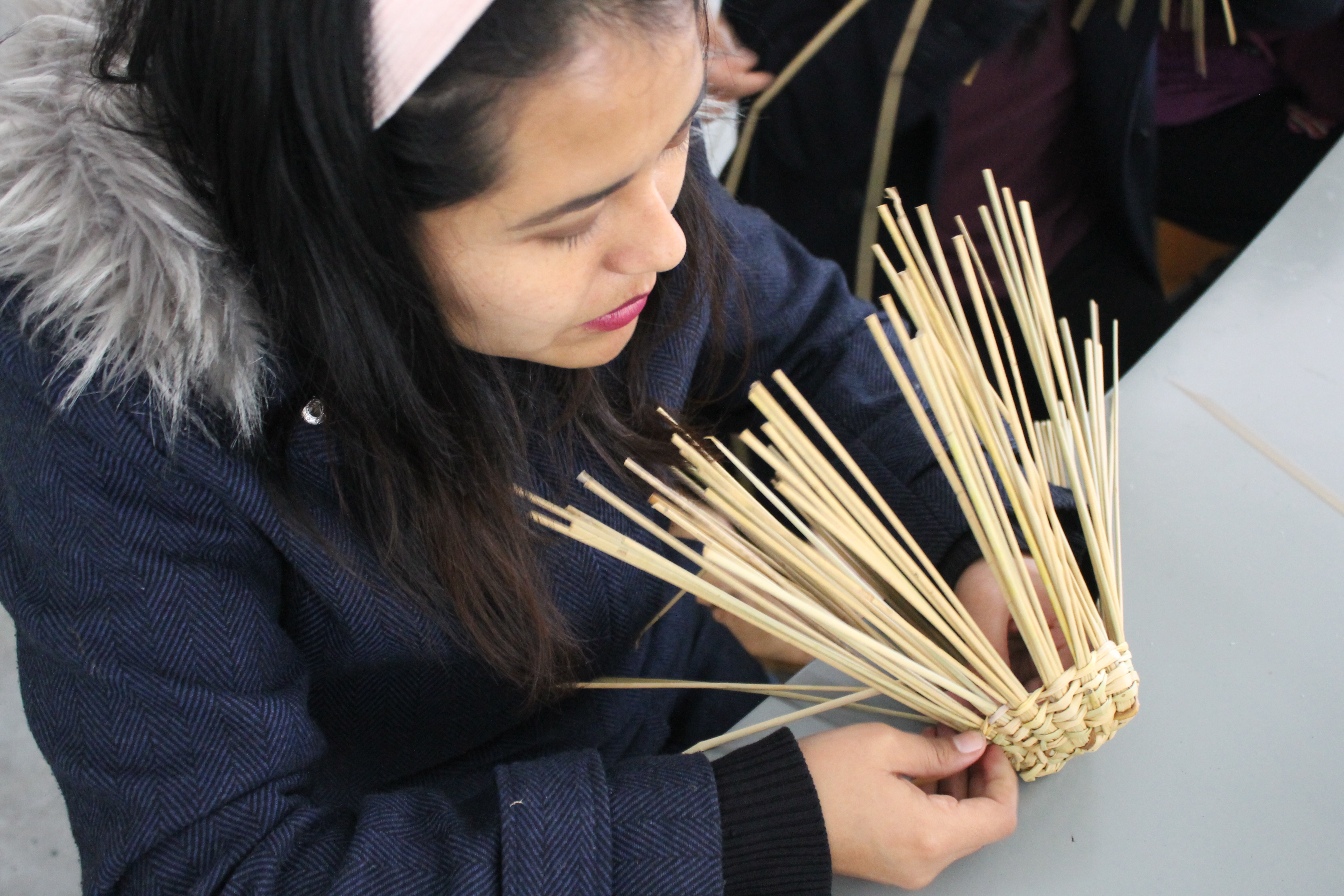
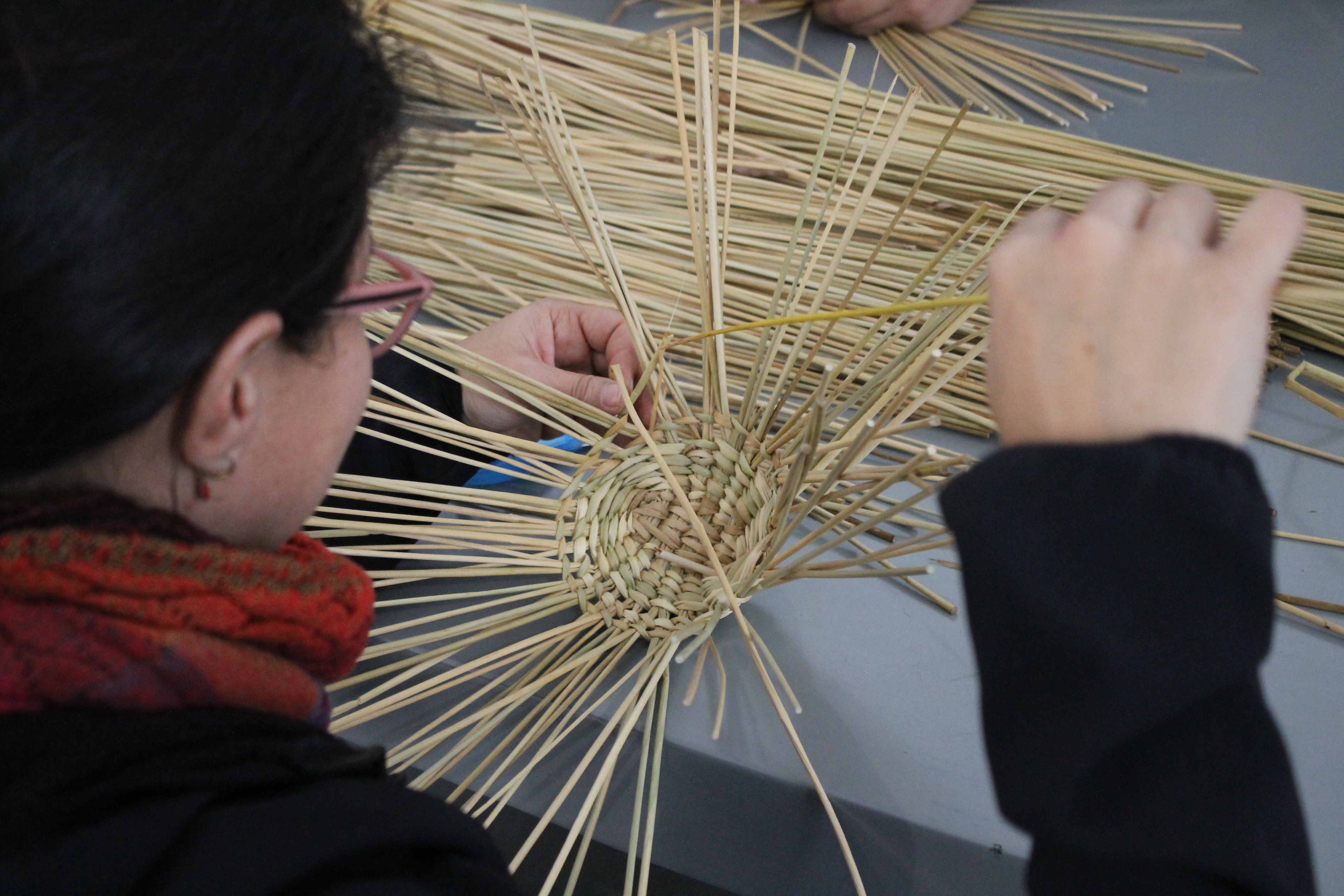
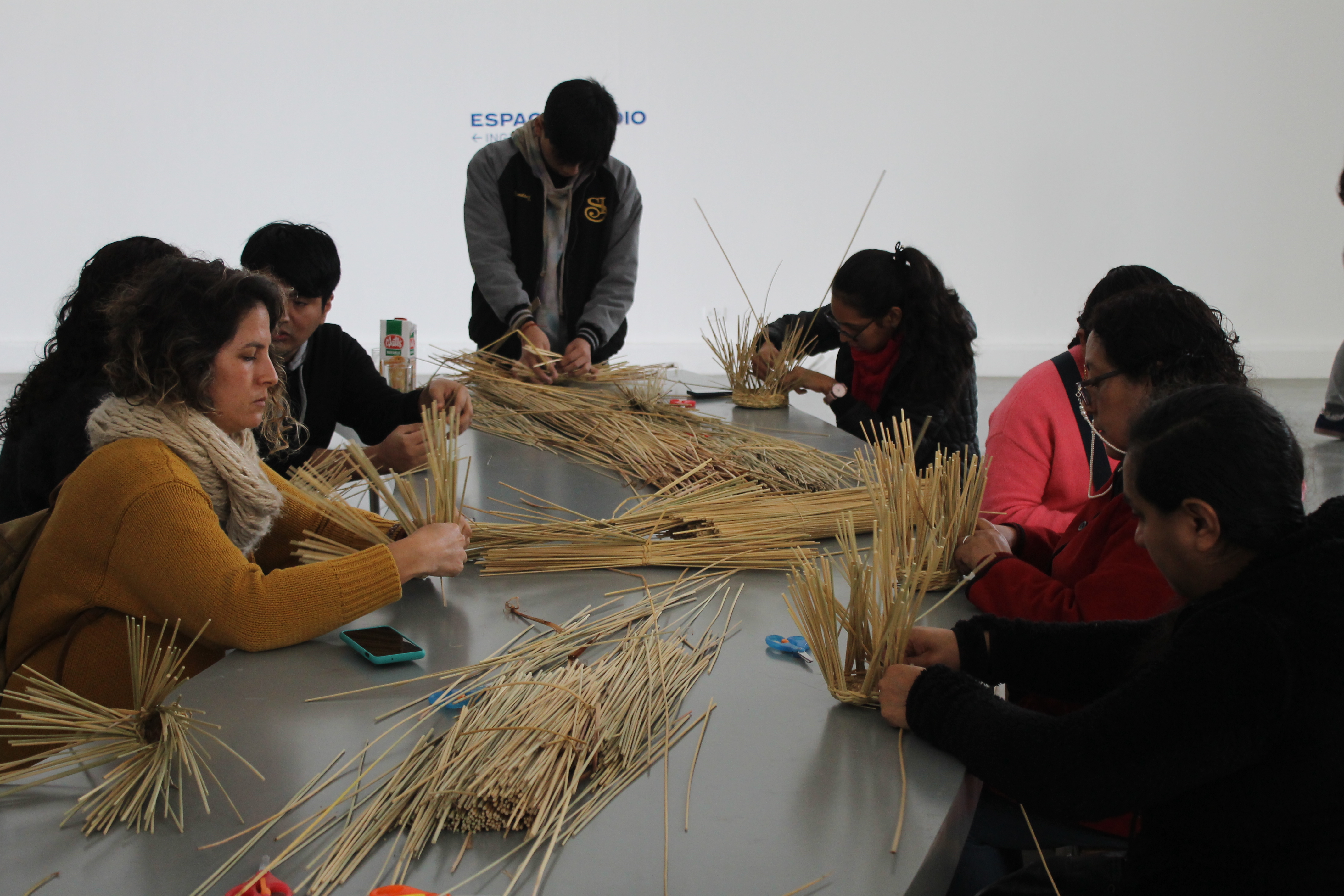
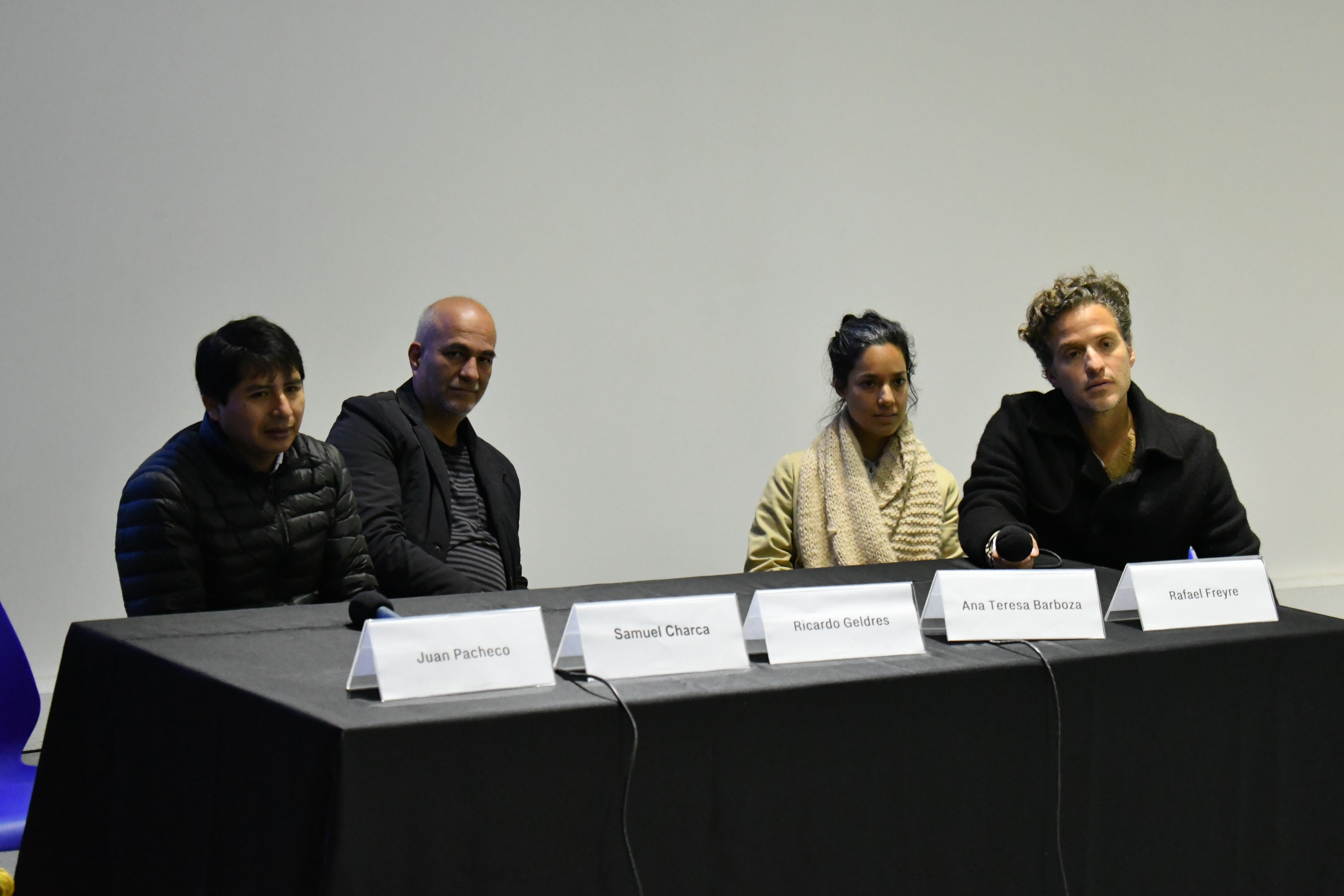
Juan Pacheco, Ricardo Geldres, Ana Teresa Barboza y Rafael Freyre dialogan sobre el diseño y arte con junco y totora. Juan Pacheco, Ricardo Geldres, Ana Teresa Barboza and Rafael Freyre discuss design and art based in reed and cattail.

Exposición de diseños en junco y totora. Exhibition of designs in reed and cattail.
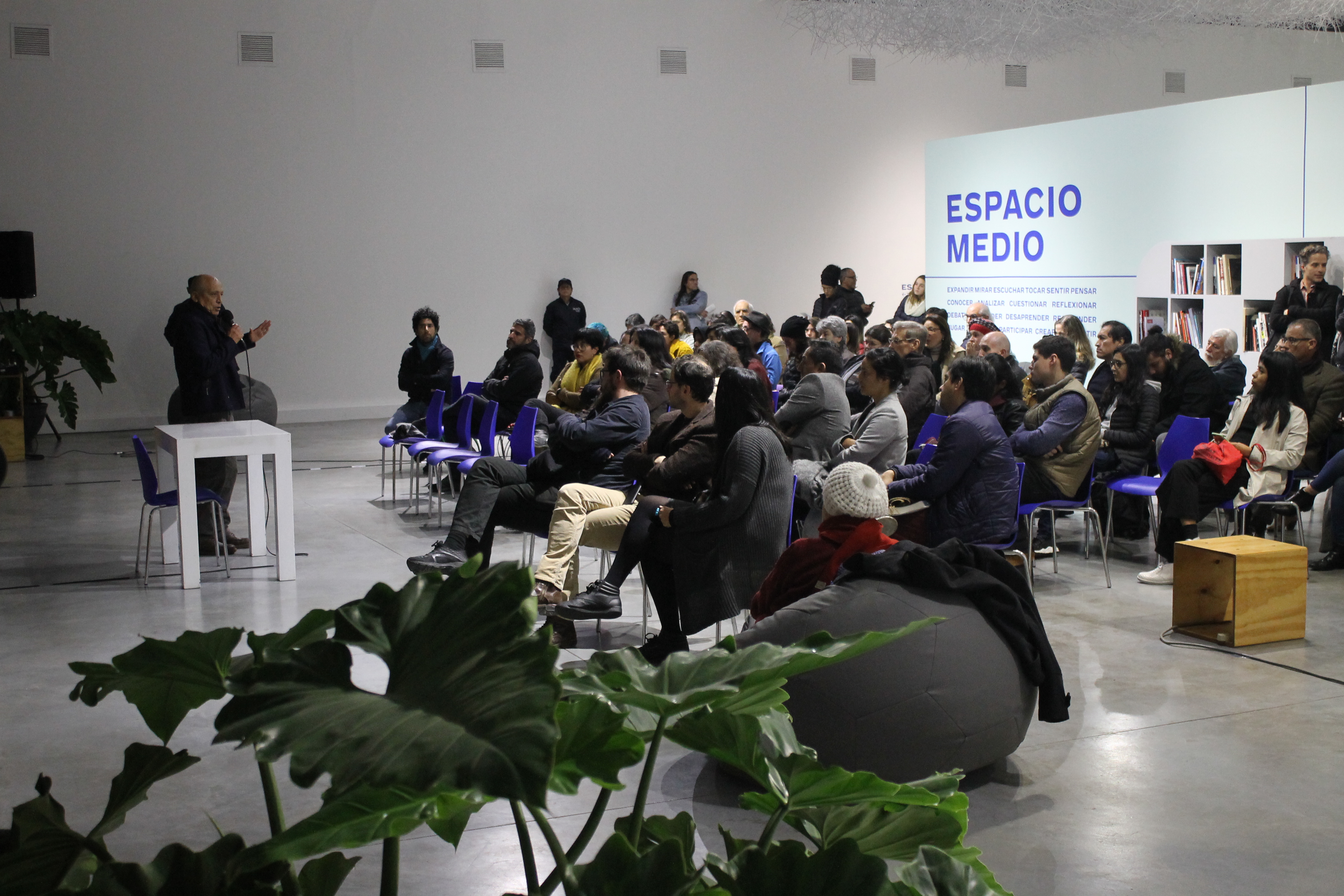
Carlos Cueva en la presentación de Paisajes Escénicos de LOT. Carlos Cueva in the presentation of Scenic Landscapes of LOT.
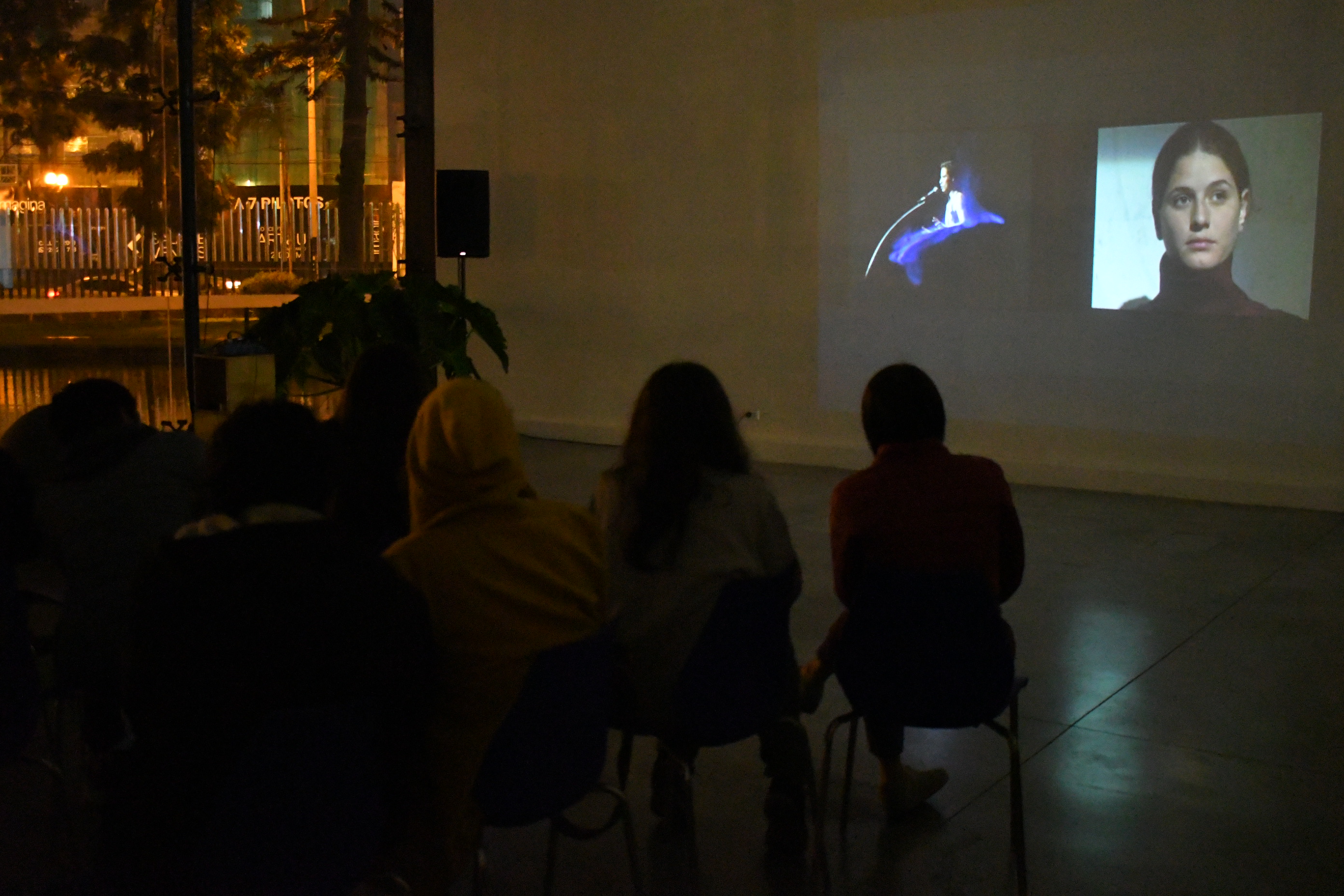
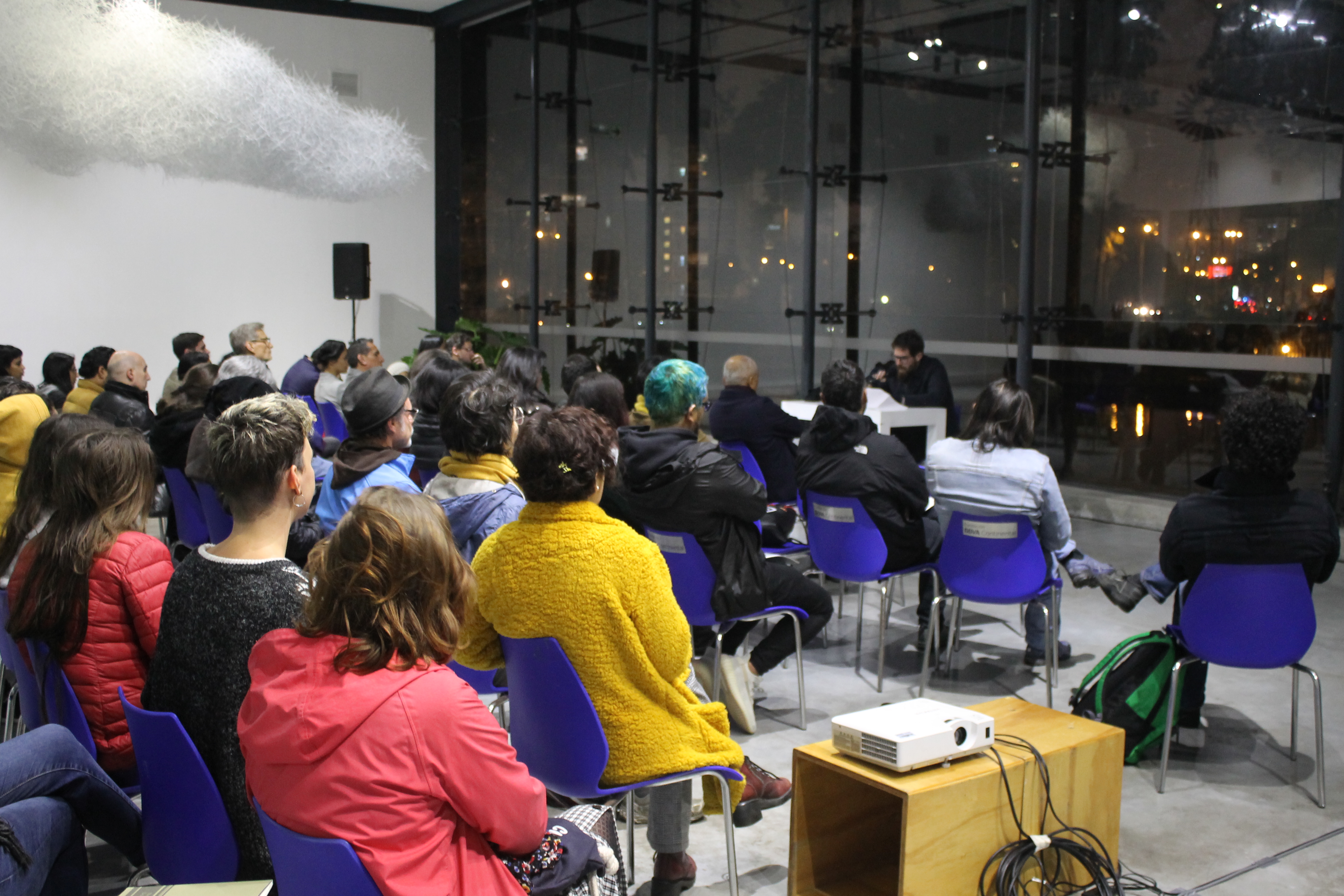
Mijail Mitrovic presenta "Sujeto, espacio, utopía". Mijail Mitrovic presents "Subject, space, utopia".
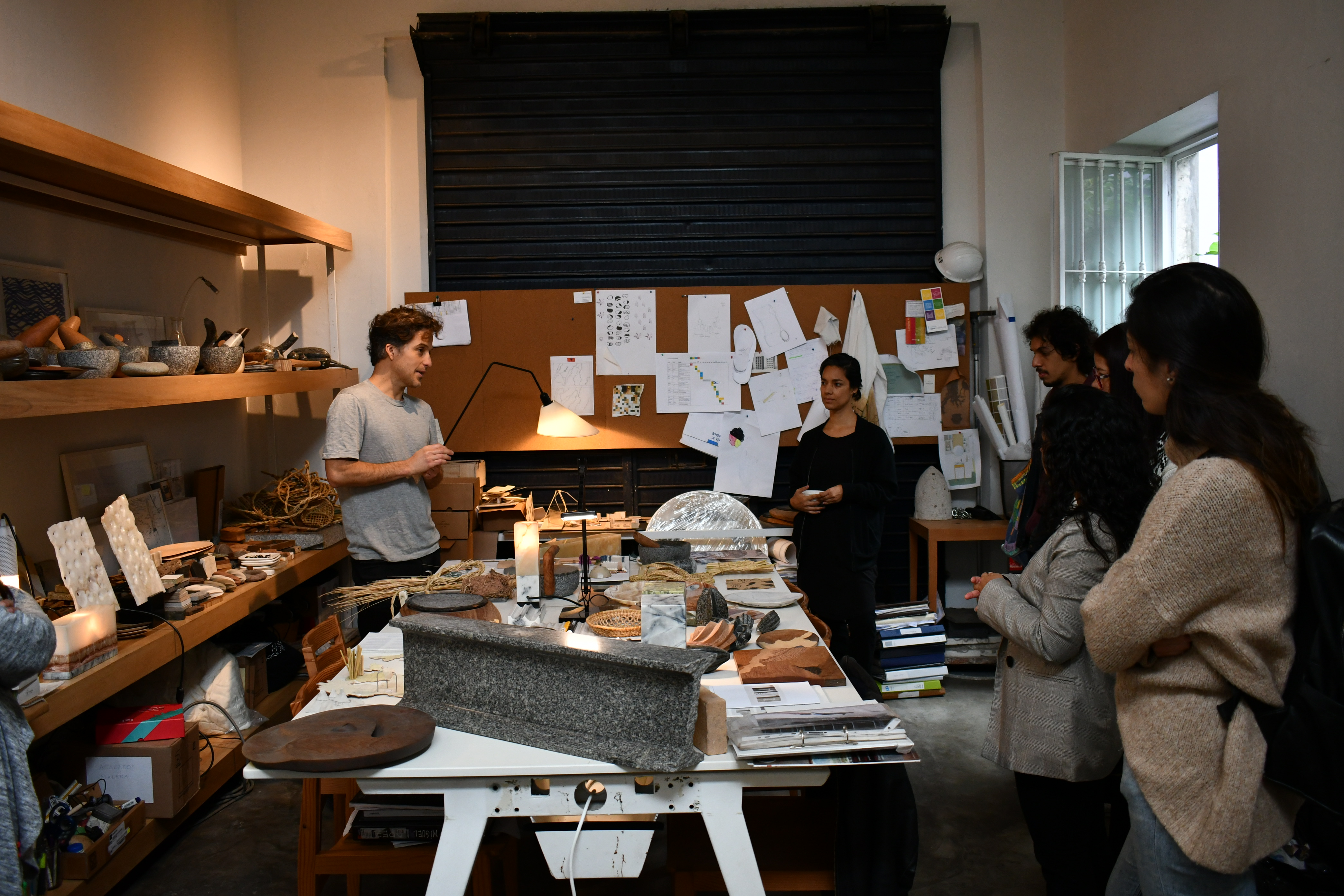
Ana y Rafael abren las puertas de sus talleres para hablar de sus procesos creativos con materiales naturales. Ana and Rafael open the doors of their workshops to talk about their creative processes with natural materials.
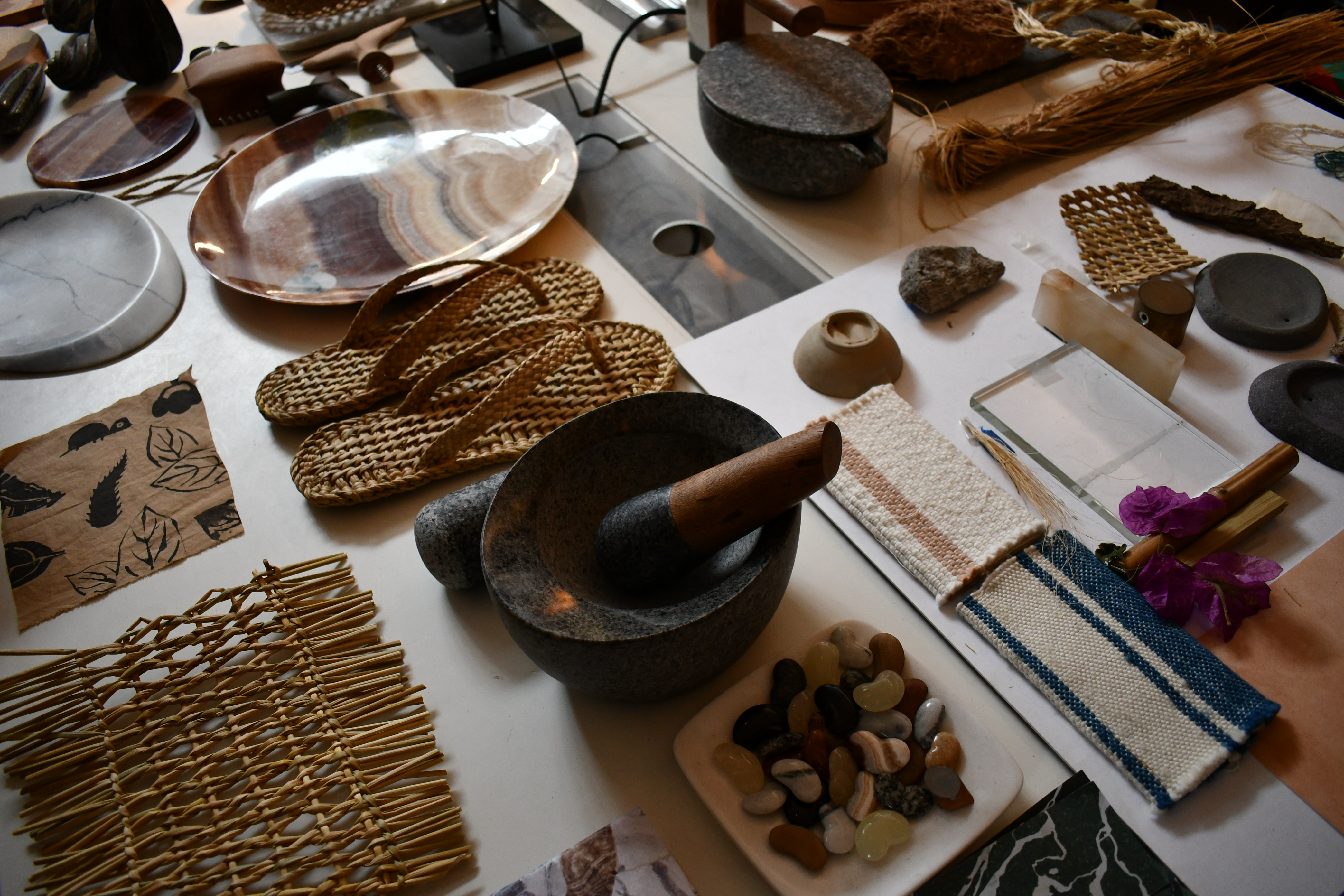
Diseño peruano contemporáneo. Piezas de junco, piedra y madera diseñadas por Estudio Rafael Freyre. Contemporary peruvian design. Reed, stone and wood pieces designed by Estudio Rafael Freyre.
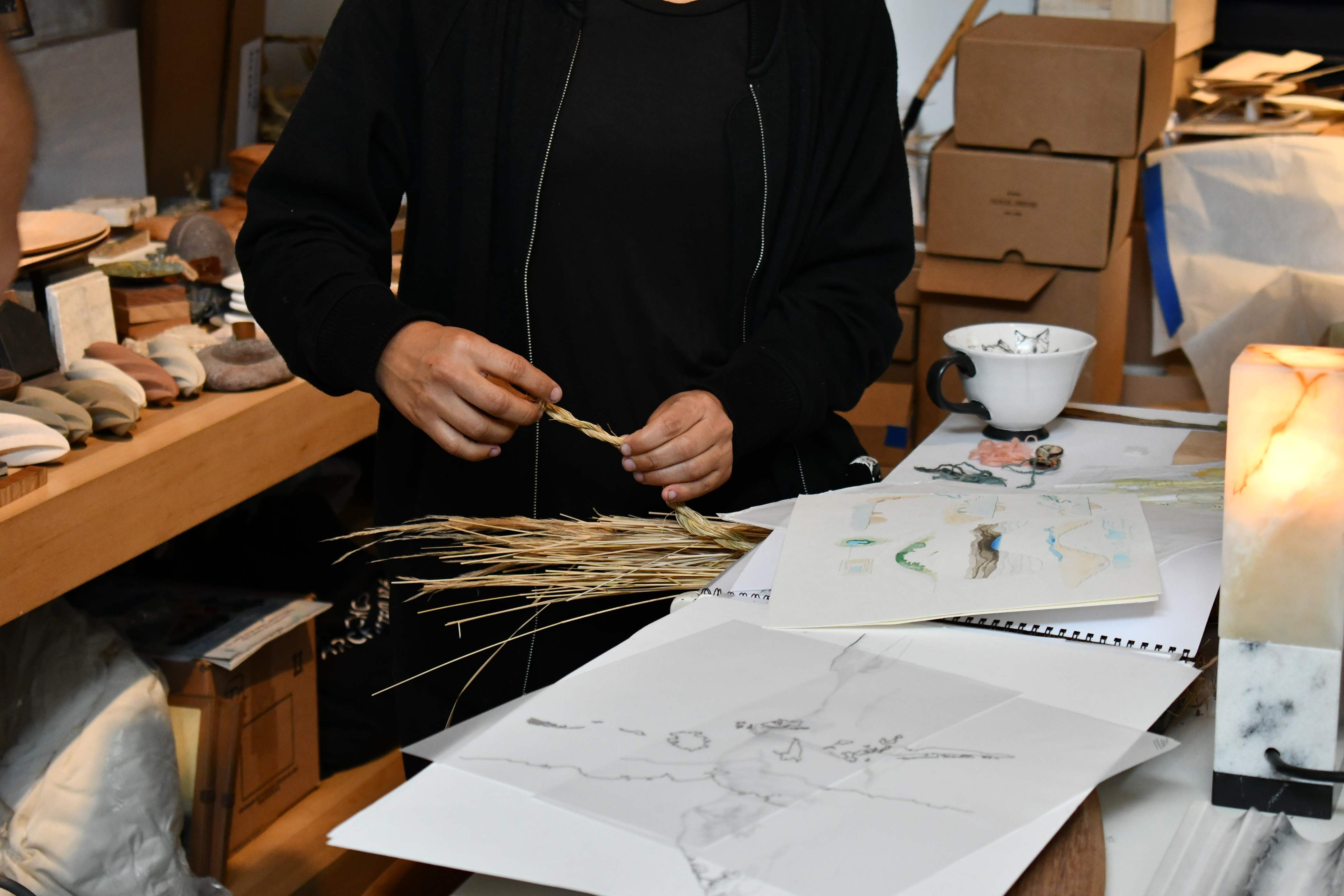
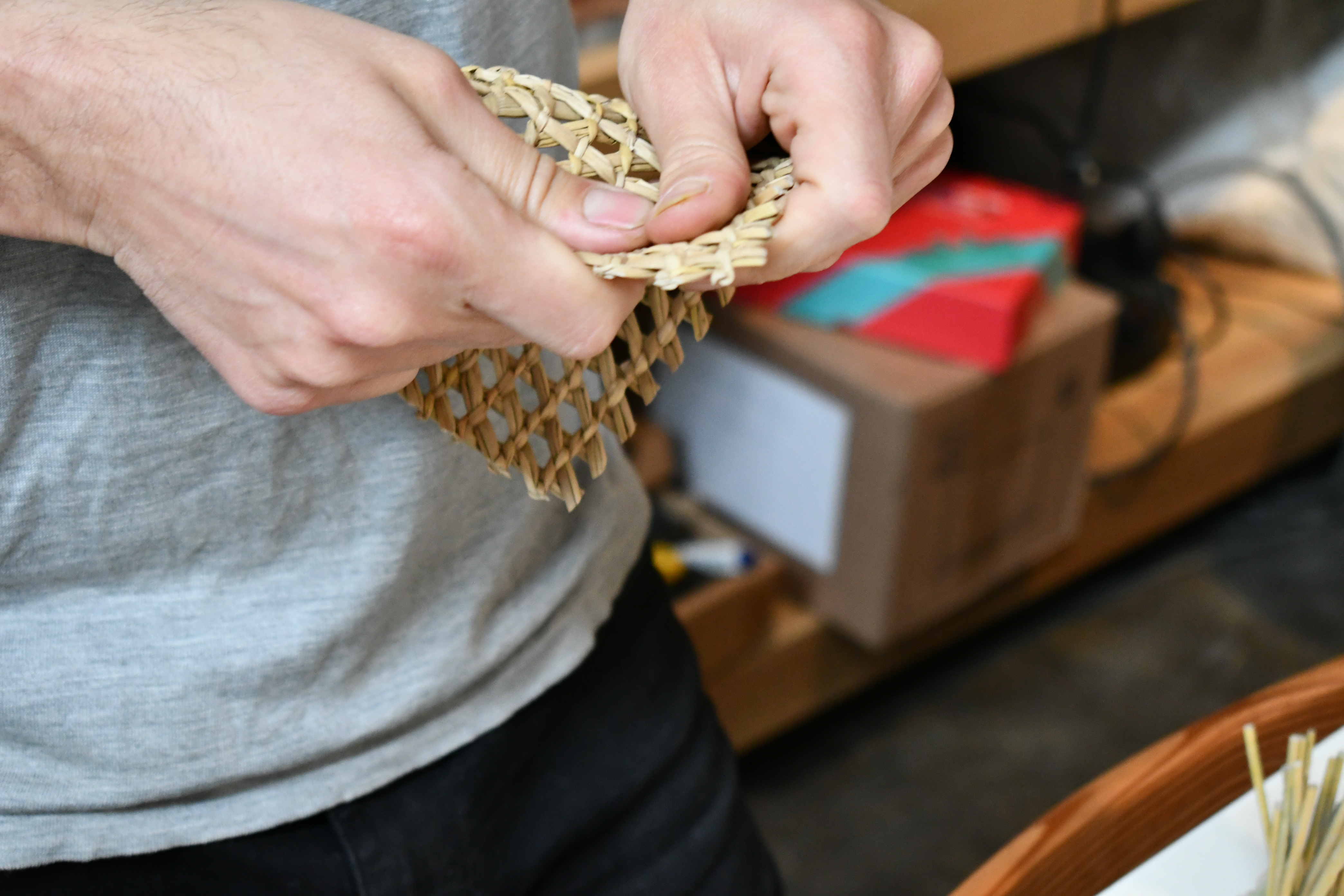
Experimentación con materiales locales. Prototipo de tejido con totóra. Experimentation with local materials. Tissue prototype with totóra.
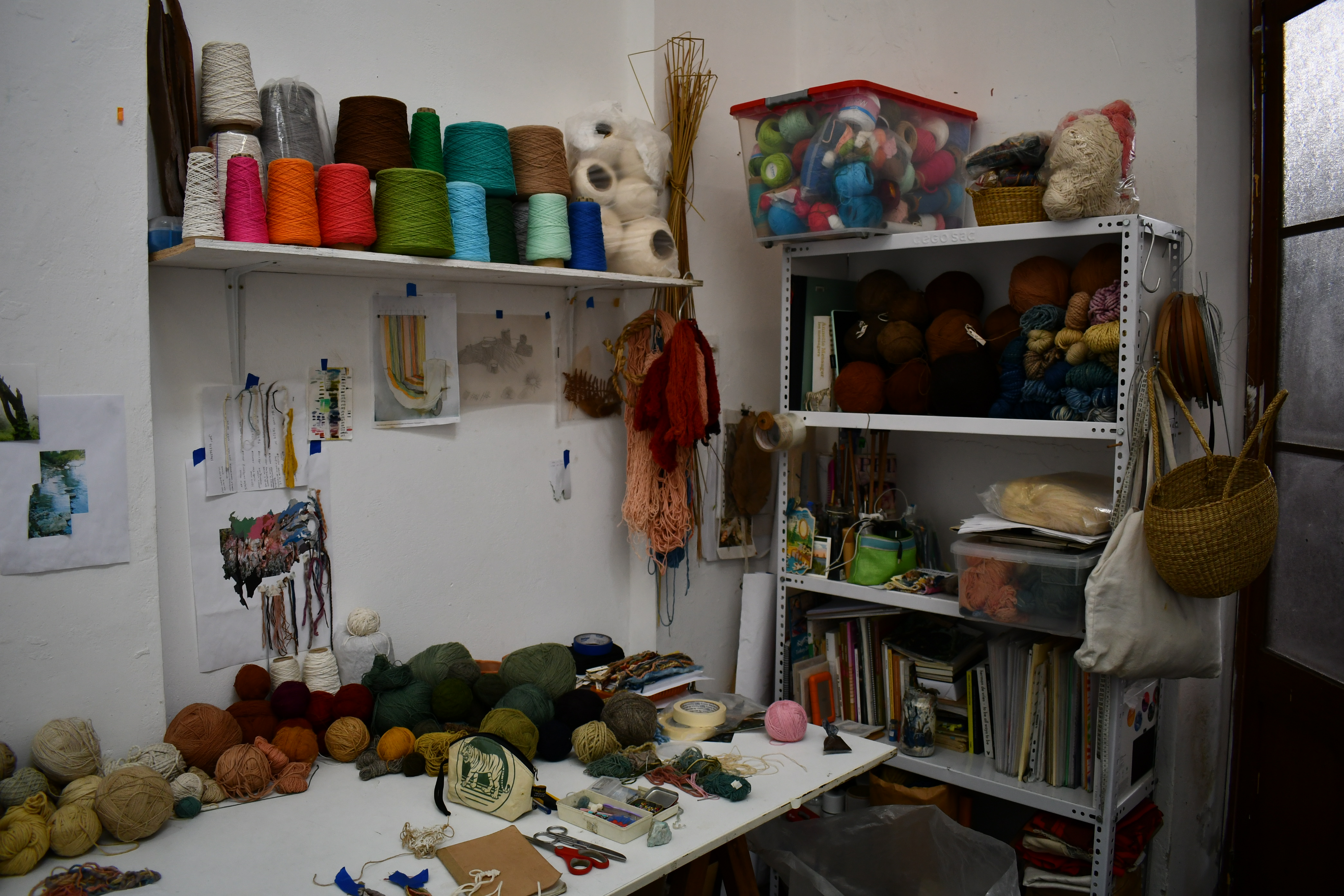
Arte textil contemporáneo. Taller de Ana Teresa Barboza. Contemporary textile art. Ana Teresa Barboza's workshop.
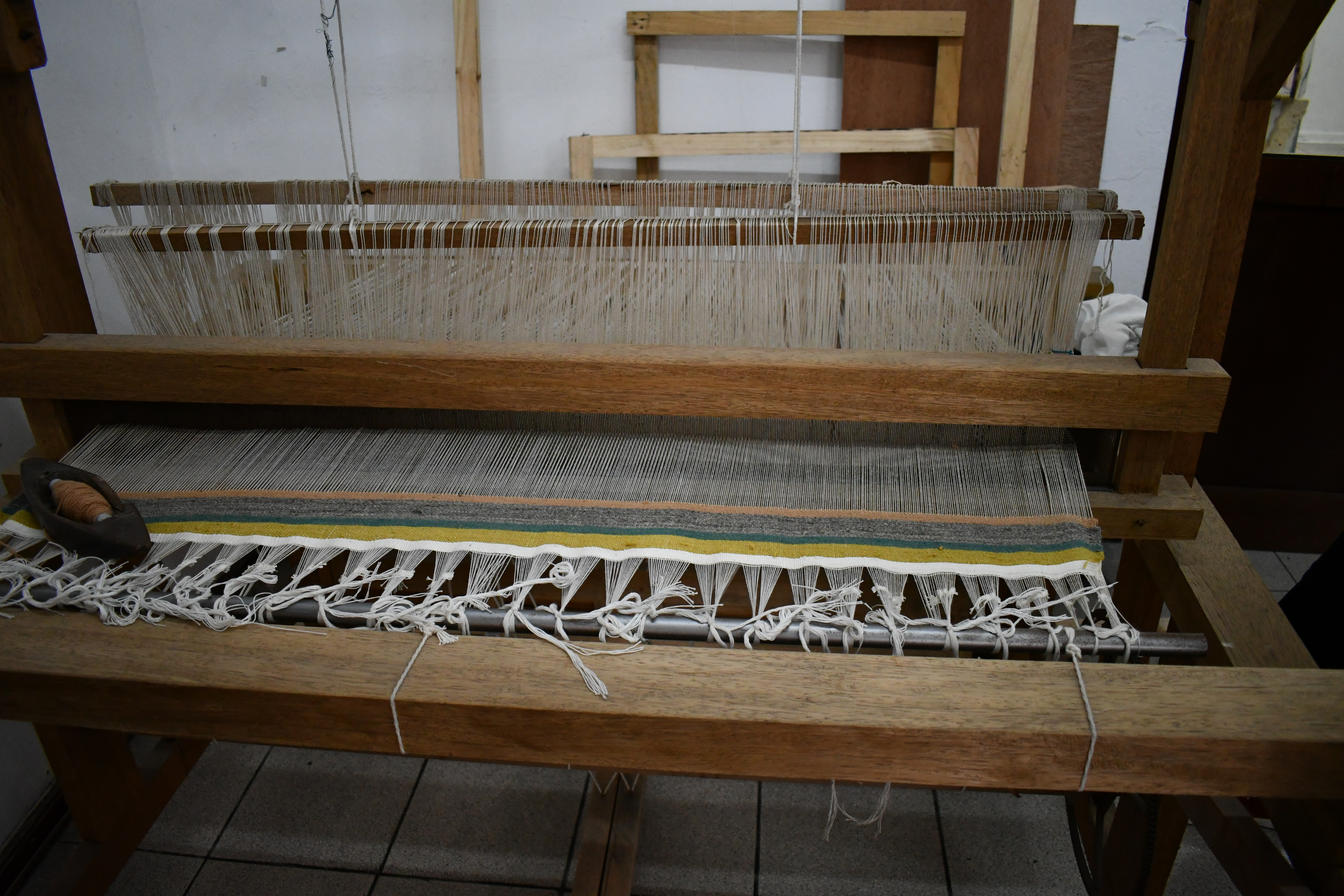
La artista Ana Teresa Barboza teje sus piezas con la máquina del telar. The artist Ana Teresa Barboza weaves her pieces with a loom machine.
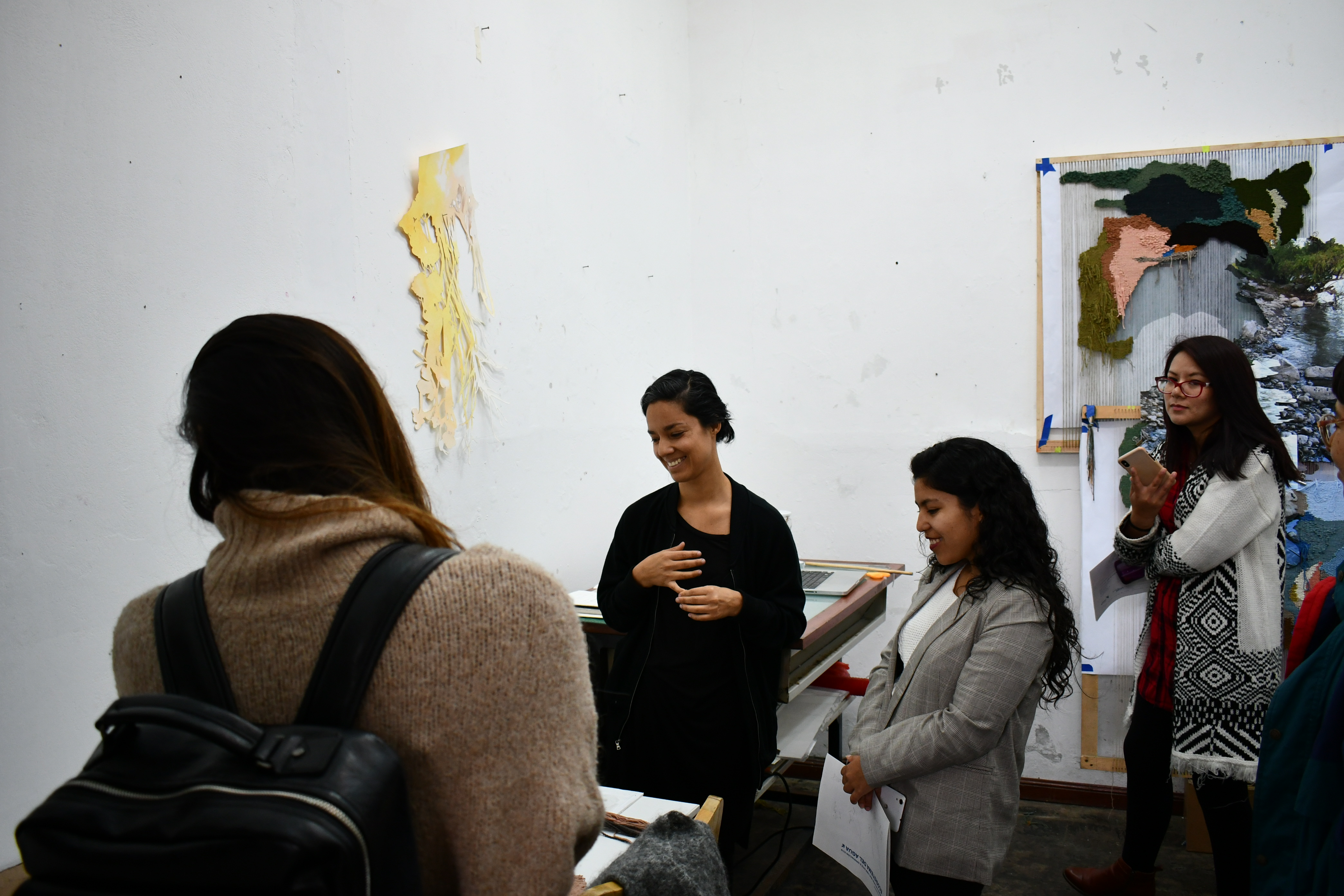
Ana Teresa Barboza explica sus procesos creativos con distintos tipos de fibras. Ana Teresa Barboza explains her creative processes with different types of fibers.
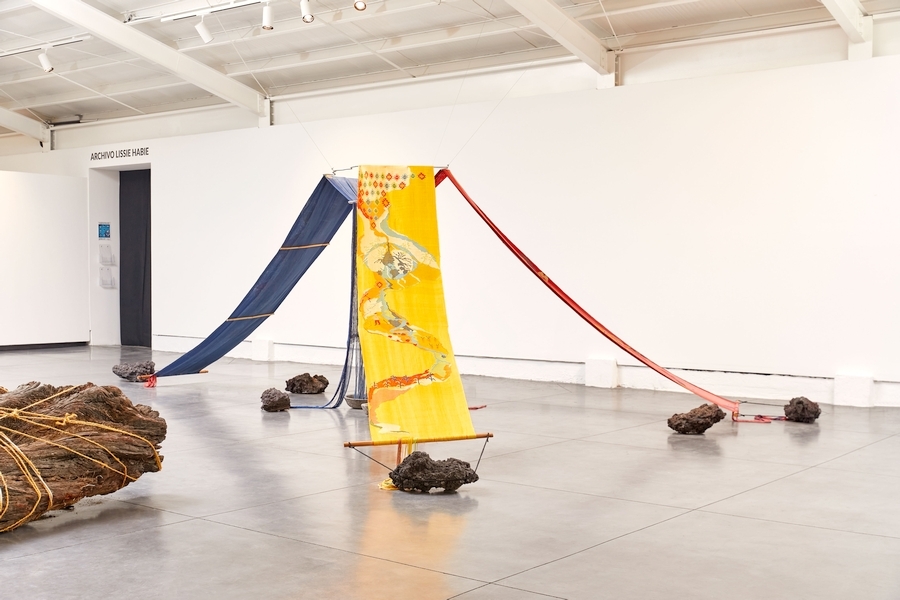
'Manto: Union de las fuerzas', instalación de Ana Barboza y Rafael Freyre para Bienal Arte Paiz. 'Cloak: Union of forces', installation by Ana Barboza and Rafael Freyre for Arte Paiz Biennale.
22° BIENAL DE ARTE PAIZ
The 22nd Bienal de Art Paiz (BAP) was held in Guatemala from May 6 to June 6, 2021. In this edition 40 local and international artists investigated themes of contemporary history, establishing points of encounter between art and the current context of Latin America. The approach was from an indigenous perspective, a particularly relevant topic in Guatemala, which is a multiethnic, multicultural and multilingual society. Ana Teresa Barboza and Rafael Freyre were among the international artists invited to participate in the thematic axis: ‘Universes of matter’. They presented the project ‘Manto’.
UNIVERSES OF MATTER
We share an excerpt of an article by Artishock magazine which highlights the role of textiles as millenary knowledge that is present in ‘Universes of Matter’:
Universes of Matter includes a nucleus of works, specially commissioned by the biennial, that reflect on matter from ritual, healing and symbolism. […] The importance of the textile tradition in Latin America finds in this section particularly heterogeneous declinations where the textile in art results in a materiality that can be a means, a resource or a millenary knowledge. This is the case of Antonio Pichillá’s loom, mentioned above, or the textiles of Peruvian Ana Teresa Barboza (1981, Lima, Peru) and Rafael Freyre (1978, Lima, Peru) that simulate cross-sections of the earth’s strata.
CLOAK
The project is based on the idea of the volcano as a contained energy that generates destruction and new life: a space where many forces and flows are concentrated. Ana and Rafael conceive the work as a collective weaving, made in collaboration with local weavers who preserve the practices of backstrap loom weaving and dyeing with plants. These practices are associated with natural cycles and a chain of interconnected processes, where the final result is a common fabric that contains processes and knowledge of the communities, the body, the plants, the climate and the territory we inhabit.
When talking with the weavers of the community of San Antonio Aguas Calientes, Ana and Rafael ask them to imagine the flow of lava that emerges from within the earth and descends, taking the form of a fabric created by them. Thus, the transforming energy that comes out of the volcano is the same energy that comes out of their hands as they weave. And they invite them to imagine that, by weaving, they can transform the earth and history: to see the lava flow as a new opportunity, a new beginning to change their environment. The work attempts to transform the women’s voices into living weavings and flows of their history, territory and culture.
TITLE
CLOAK
UNION OF FORCES
ARTISTS
ANA TERESA BARBOZA
& RAFAEL FREYRE
PLACE
GUATEMALA
YEAR
2021
DESCRIPTION
COLLECTIVE WEAVING
BASED ON STORIES
BY DINORA LOPEZ,
ALIDA LOPEZ,
CLAUDIA TELON
AND CATALINA HERNANDEZ
MATERIALS AND TECHNIQUE
THE INSTALLATION INCLUDES
LOCAL VOLCANIC STONES,
PLATES WITH COCHINEAL, INDIGO
AND PALO AMARILLO DYES,
AND BACKSTRAP LOOM WEAVINGS
OF COTTON FIBER DYED WITH LOCAL
NATUARAL DYES IN SAN ANTONIO
AGUAS CALIENTES, GUATEMALA
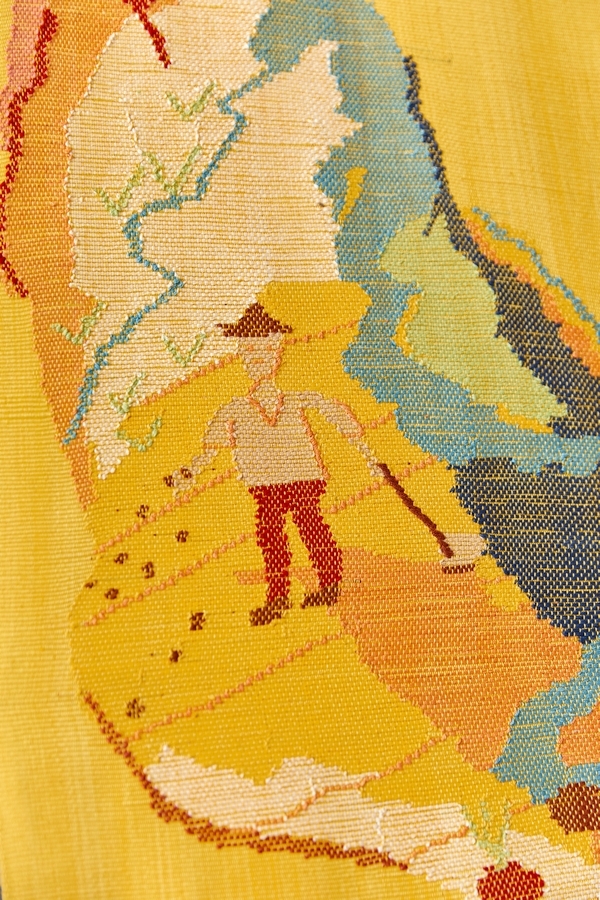
Detalle de pieza tejida con bordados. Detail of woven piece with embroidery.

'Manto: Union de las fuerzas', instalación de Ana Barboza y Rafael Freyre para Bienal Arte Paiz. 'Cloak: Union of forces', installation by Ana Barboza and Rafael Freyre for Arte Paiz Biennale.
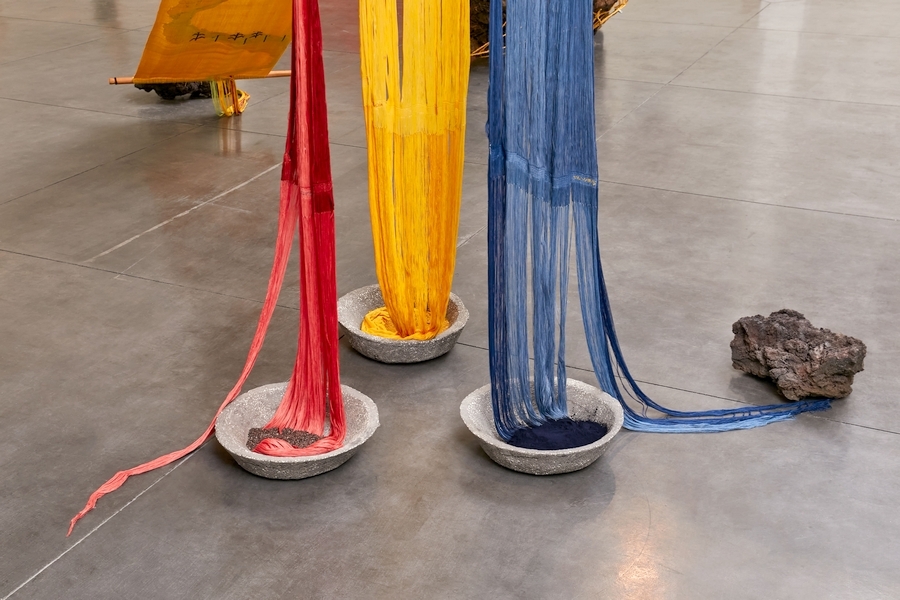
Fibras teñidas con tintes naturales. Fibres with natural dyes.
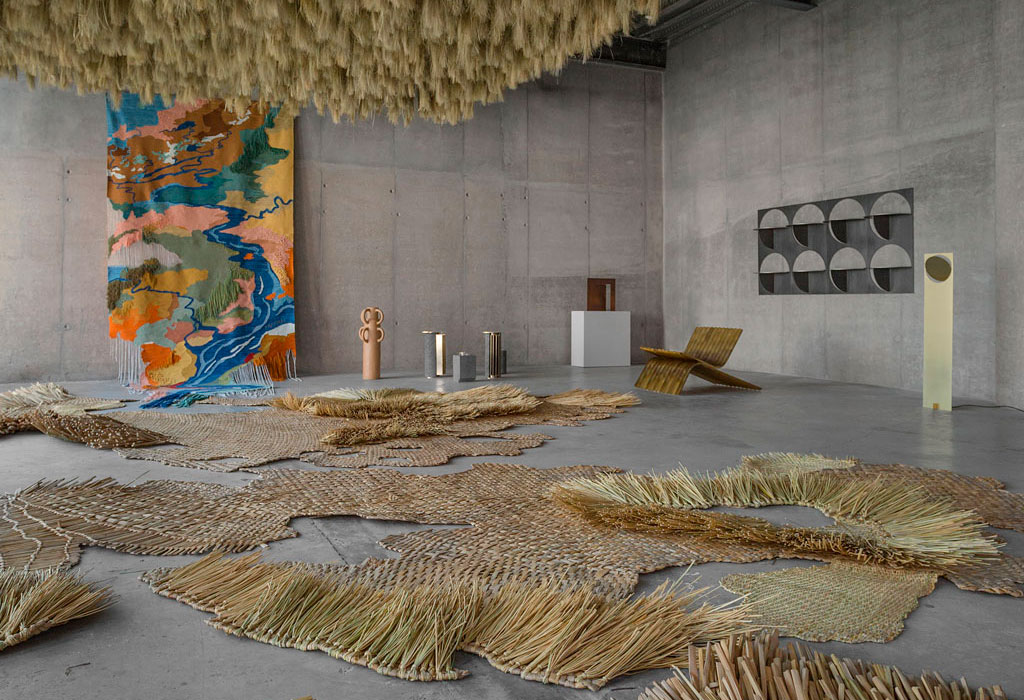
Vista de Exhibición Transatlántico. View of Transatlantico Exhibition
TRANSATLANTICO
AMAZON RIVER & WETLANDS
Transatlántico was an exhibition of sculptural art from Latin America curated by Galerie Philia in Mexico city. The exhibition brought together a new generation of Latin American designers from Mexico, Argentina, Colombia, Peru, Puerto Rico, Venezuela, and the Dominican Republic, in dialogue with leading designers from Europe.
Estudio RF presented ‘Amazon River’ and ‘Wetlands’, two pieces that explore the relation between water and the peruvian territorry. Water descending from the Andes glacier irrigates both Pacific and Atlantic ecosystems: the dry pacific coast and the amazon rainforest. Through water, vegetable and animal biodeversity flourishes and connects with local communities as a continuous and collective weaving.
ABOUT WETLANDS SERIES
The Wetlands pieces are developed from research around coastal wetland ecosystems, where plant species such as reeds and cattails grow. With these fibers the first fabrics were developed in 6000 BC in Peru. These ecosystems serve as a transit point for migratory birds and guano birds that come in search of warm climates from various places: the islands, the Andes, the Amazon and different regions from the North and South Poles to the equatorial zones. Wetlands are a natural filter thanks to the plants that grow in them. In addition, their capacity to retain water makes them one of the most productive ecosystems in the biosphere.
ABOUT RIVER SERIES
Water articulates the soils we inhabit. Descending from the Andes, from glacials and highland wetlands to lagoons, it irrigates the lower lands through old channels. The hand-woven pieces integrate the work of hand yarning and dyeing with local plants from different highland and coastal communities of Peru. Each color of the tapestry comes from a different botanical species. Weaving is a collective act, where different forces between artists and territories join.
AMAZON RIVER 2022
COLABORATION
ANA BARBOZA
LOOM WORK
ELVIA PAUCAR
ASSISTANCE
LIZ QUISPE
MARIEL REYES
ANDREA TAPIA
DESIGN MANAGEMENT
MARI RETAMOZO
MATERIAL
COTTON AND WOOL DYED WITH BOTANICAL COLORS
BY DIFFERENT COMMUNITIES FROM THE ANDES AND THE COAST
MEASUREMENT
200 X 400 CM
TECHNIQUE
TRADITIONAL LOOM AND HAND EMBROIDERY
WETLANDS 2022
REED AND TOTORA WEAVING
DAVID GOICOCHEA & FAMILY
ASSISTANCE
ANA BARBOZA
DESIGN MANAGEMENT
MARI RETAMOZO
MATERIAL
REED AND TOTORA FIBRE FROM HUACHO WETLANDS
MEASUREMENT
5 X 8 M
TECHNIQUE
HAND WEAVING
PHOTOS
MARIANA ACHACH
MEXICO DF
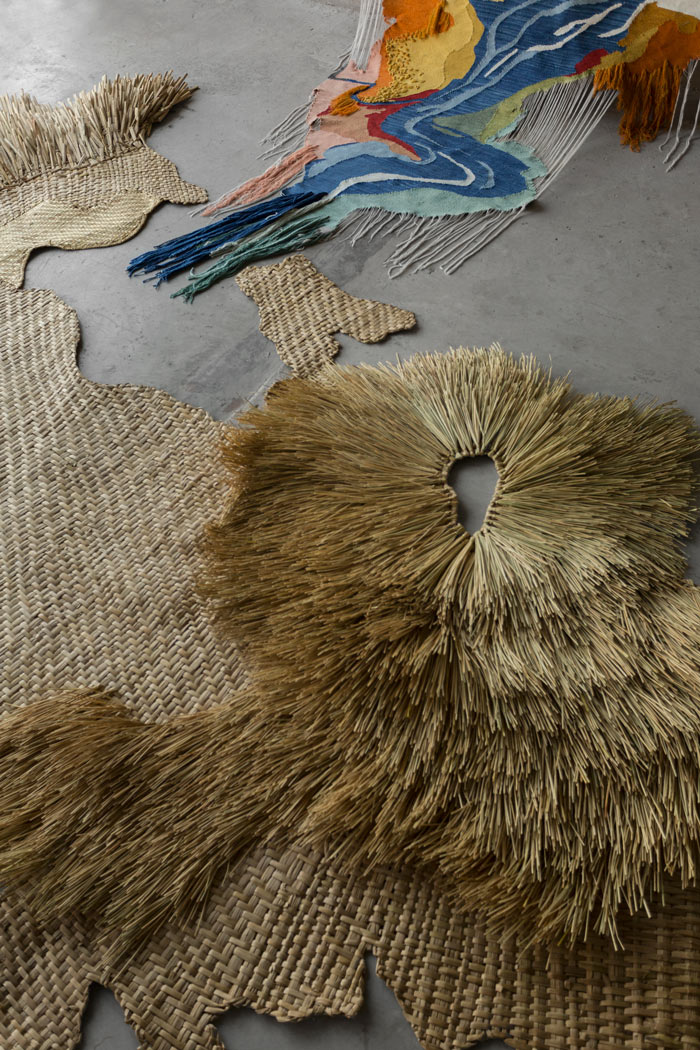
Detalle de tejido en junco. Detail of reed weaving.
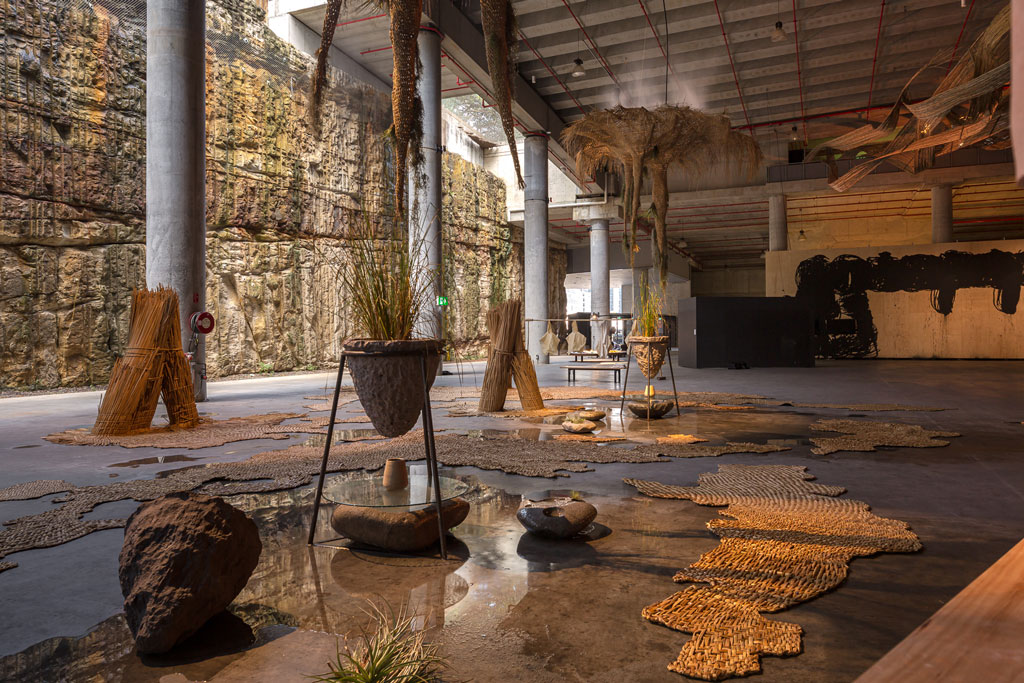
Ecosistema del agua en The Cutaway, un espacio de origen residual en la ciudad. El gran corte en la roca devela los estratos geológicos de Sídney. The Water Ecosystem in The Cutaway, a space of residual origin in the city. The large cut in the rock reveals the geological strata of Sydney.
RIVUS: 23RD BIENNALE OF SYDNEY
” It is not a Biennale about rivers, or water for that matter; it’s a Biennale about bodies of water and the ecologies they sustain, and it branches out into ideas of the rights of nature and voice of nature … inter species collaboration, the voice of the non-human, and many more ideas. ”
Artistic Director of the 23rd Sydney Biennale, Jose Roca
The 23rth Biennale of Sydney is titled ‘rīvus’ after the Latin for ‘stream’. Rivus navigates the complexities of our relationship with nature, now in open crisis, and its wide array of participants articulate diverse responses to this troubled relationship. The projects reimagine the social and environmental landscape of our times in a world that has been so radically reshaped by human activity. In the words of the Biennale organization:
“ rīvus, reflects on its own conditions of possibility, becoming the catalyst for works already in progress; encouraging the use of non-polluting materials and production processes; advocating for locality, collectivity, collaboration and reduced waste; acknowledging its own impact on the environment while aiming to lower it through a systemic and creative approach.”
THE WATER ECOSYSTEM IN RIVUS: NEW MEANINGS
The Water Ecosystem project was presented for the first time in 2019 as a solo exhibition at the MAC museum in Lima, Peru. In 2022 The Water Ecosystem moved to Australia to participate in the 23rd Biennale of Sydney: Rivus. Relocated in the large space ‘The Cutaway’, it becomes part of a much larger system where several projects cohabit. This stems from the vision of the biennial’s curator, José Roca, who articulates works of very diverse languages in the same space: from digital, pictorial, installation, to archaeological objects. Dissimilar actors, works, languages and media can be related in proximity, amplifying their possible readings.
In the new context of Sydney, in the midst of a season of torrential rains and floods, The Water Ecosystem takes on a different dimension, where the new protagonist is now humidity: from water contained in the context of the desert, from scarcity, to excess water: a permanently humid state in which water cannot be controlled. The excess of humidity relates the project to ecosystems of water abundance, such as the Amazon. It is now a place where humans and plants coexist within this humidity.
COMMUNITIES AND VOICES OF NATURE
Stretching back thousands of years, native communities in Australia have developed a deep connection with water sources. This is not a relationship of consumption: indigenous knowledge has long understood non-human entities as living ancestral beings that must be protected, and especially rivers are part of their imaginaires. These longstanding cultural practices were cut short during colonization of Australia, and the aftermath shows a history of exclusion and exploitation. Urgent questions still unanswered: Who has a right to water? Who has a right to land? Who vouches for nature’s rights? This reckoning is happening throughout the world.
In Peru, the greatest social conflicts revolve around the same issues. Historically mistreated communities demand autonomy and access to resources and land. There is a worldwide troubled imbalance between the agency of the State, the communities, private enterprise, and nature. Against this background, there is now a global movement to grant legal rights and personhood to some plants, mountains, rivers, and bodies of water. This poses some interesting questions. In what ways can nature speak for itself? A powerful idea explored in the Biennale, where rivers, wetlands and other ecosystems are presented as life systems with agency.
The Biennale further addresses the personhood of nature by including 8 world rivers as participants: The Atrato, the Baaka/Darling, the Birrarung/Yara, the Boral, the Burramatta, the Martuwarra, the Napo and the Vilcabamba. They are represented by ancestral custodians or contemporary custodians that speak on their behalf.
PROJECT CONCEPT
ANA TERESA BARBOZA
RAFAEL FREYRE
STONEWORK
ROBERTO ROMAN
TOTORA AND REED WEAVING
DAVID GOICOCHEA AND FAMILY
CERAMIC WORK
ELIZABETH VASQUEZ
METAL WORK
JESUS MUÑOZ
PRODUCTION AND GENERAL MANAGEMENT IN LIMA
MARI RETAMOZO
PRODUCTION TEAM IN SYDNEY
TOMMY DODD
ED HORNE
BO GEORGIOU
JON DREWS
TAYA MIKAH SOLOMON
WITH THE HELP OF
MUSEO MAC LIMA
SPECIAL THANKS TO
UTEC
The Water Ecosystem was the winning project of the First National Art and Innovation Award (2019) of the Museo de Arte Contemporáneo de Lima
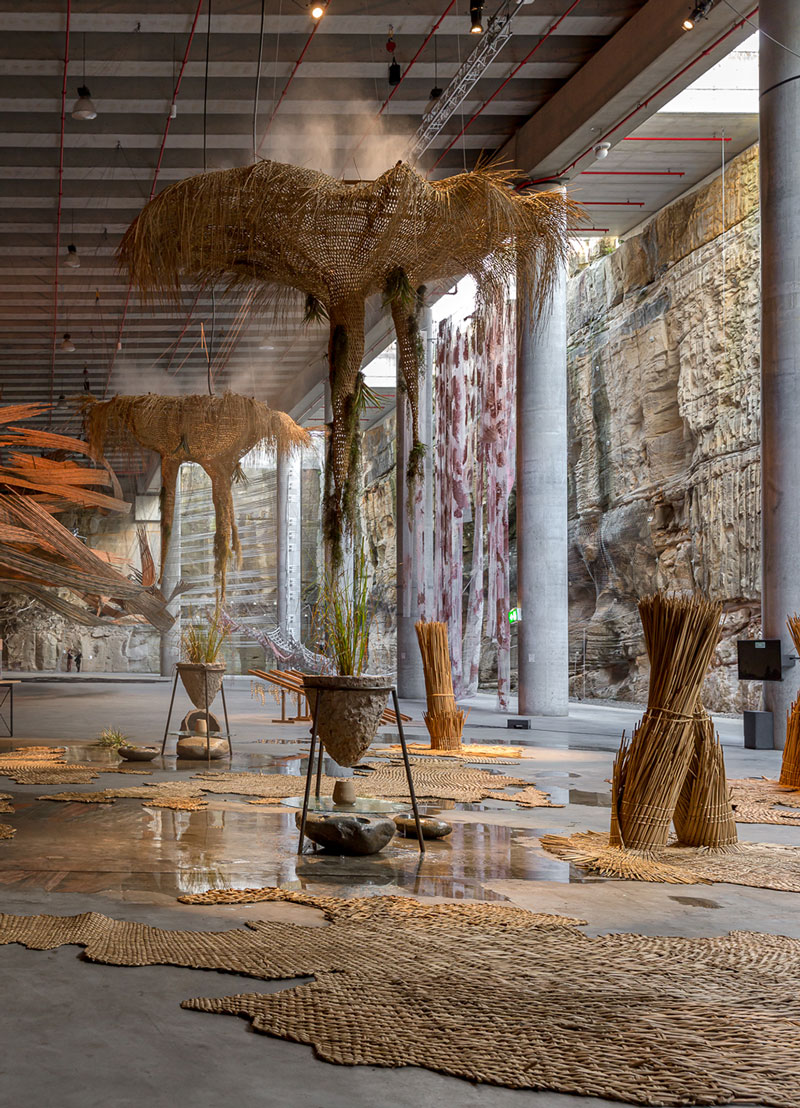
Desde su inauguración en 1973, la Bienal de Sídney ha abordado temas como el arte mundial, la globalización y las historias alternativas dentro de diversas comunidades. Since its inauguration in 1973, the Biennale of Sydney has engaged with themes of world art, globalization, and alternative histories within various communities.
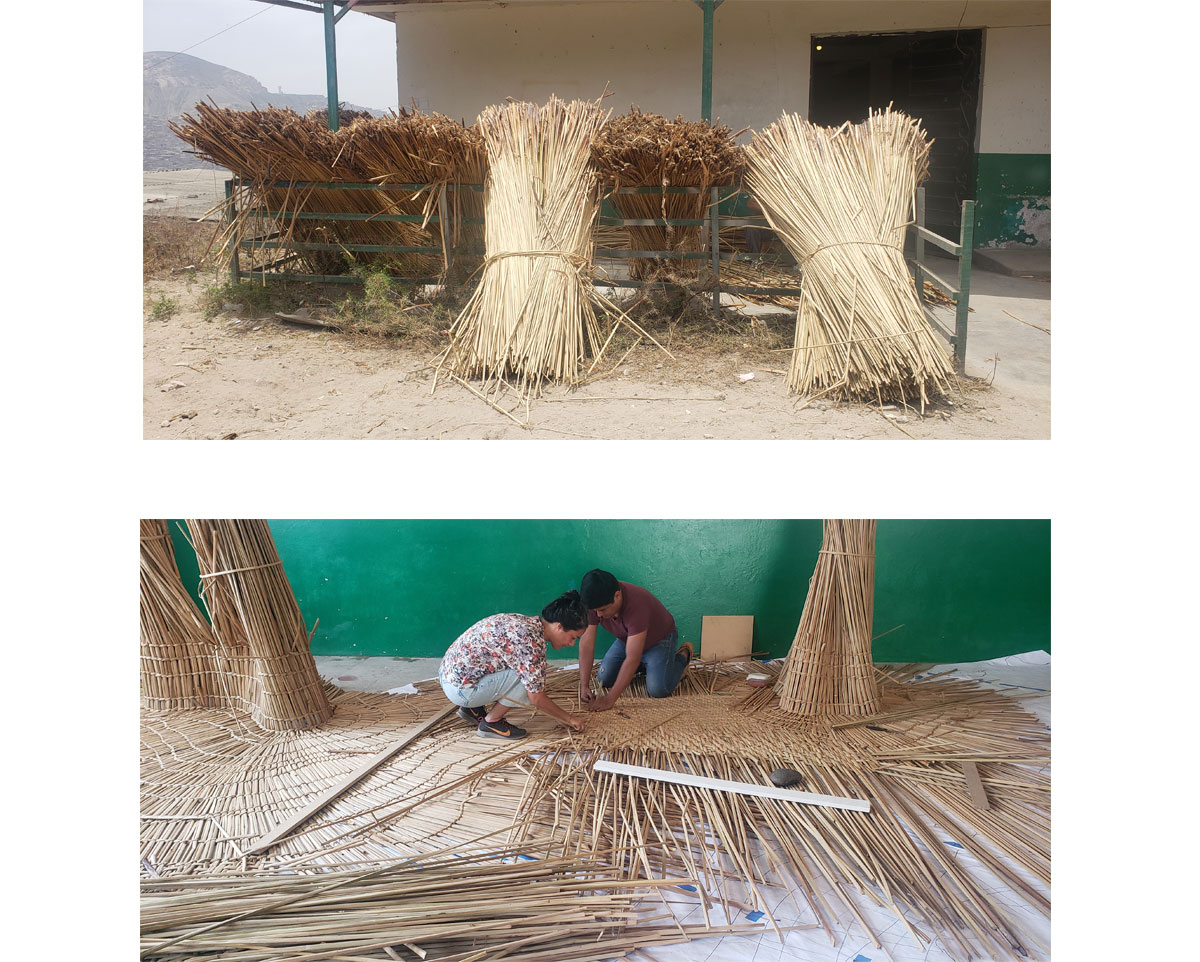
Proceso de tejido. Weaving process.
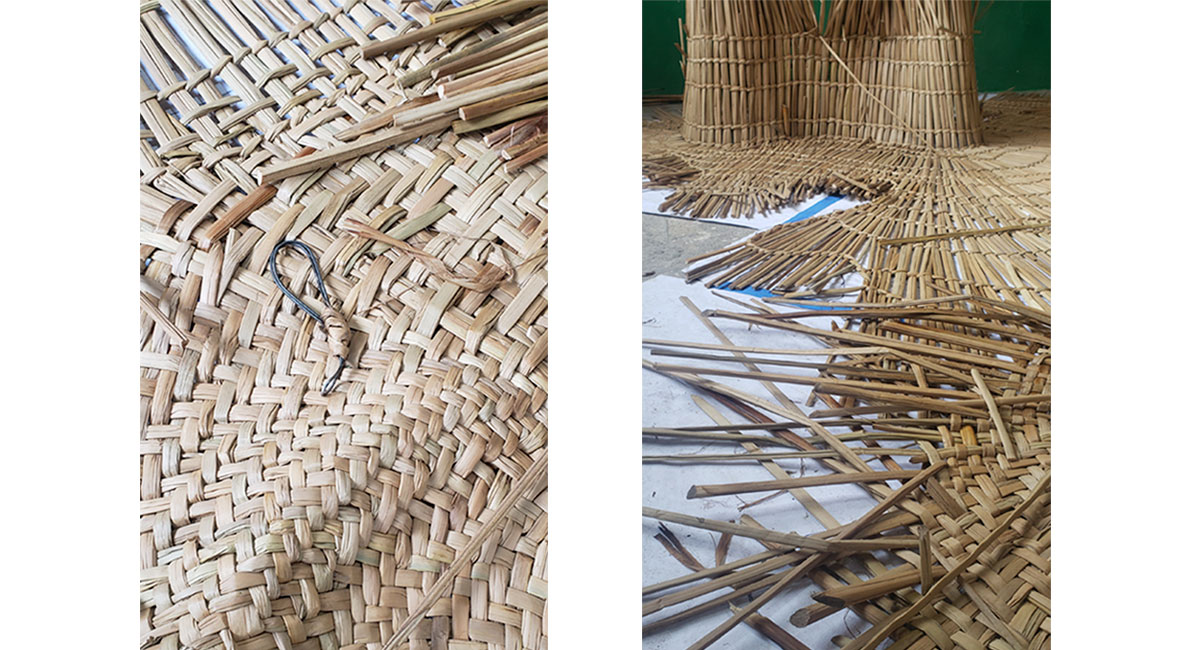
Detalle de tejido en fibra de totora. Detail of totora fiber weaving.
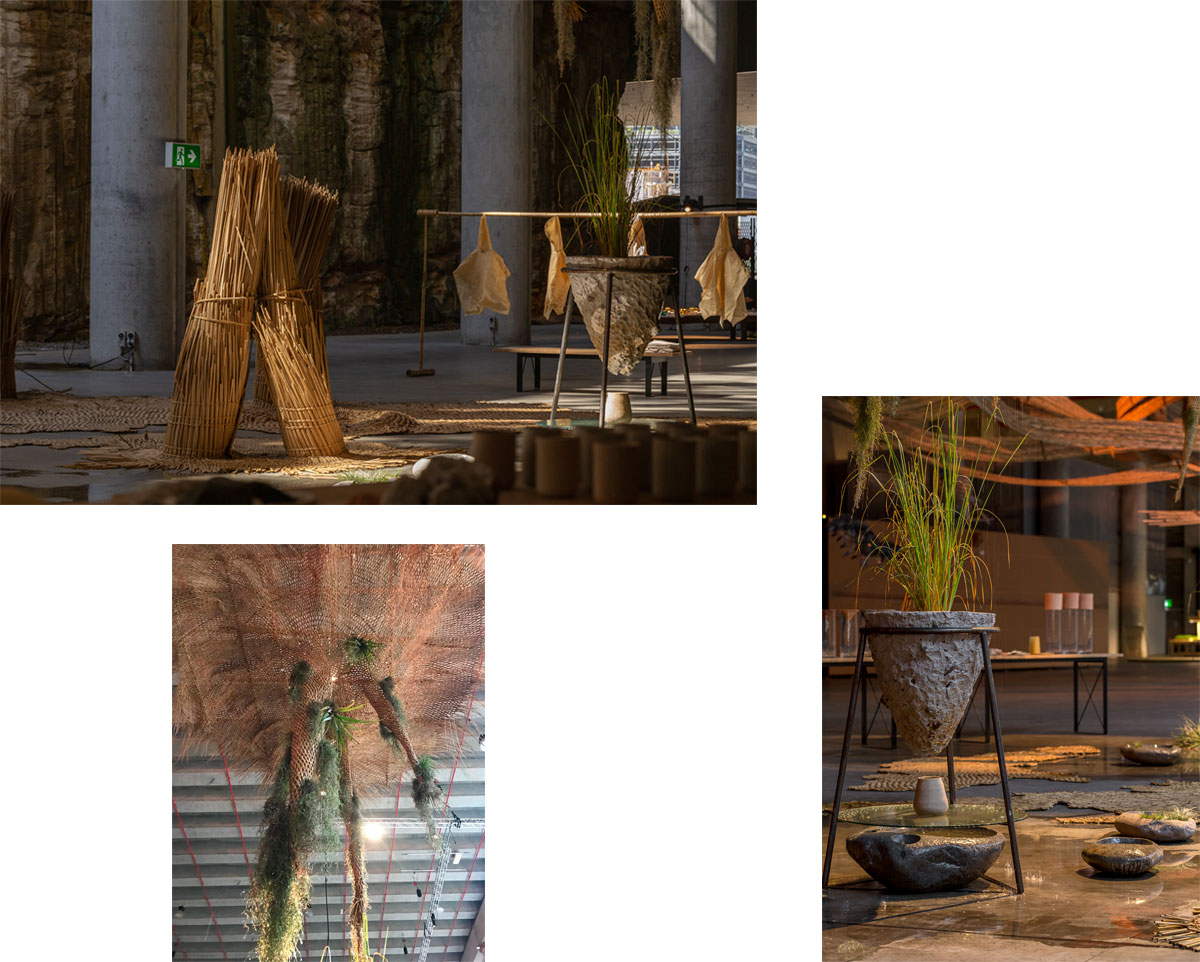
Junco, totora, piedra volcánica, vegetación. Reed, totora, volcanic rock, plants.
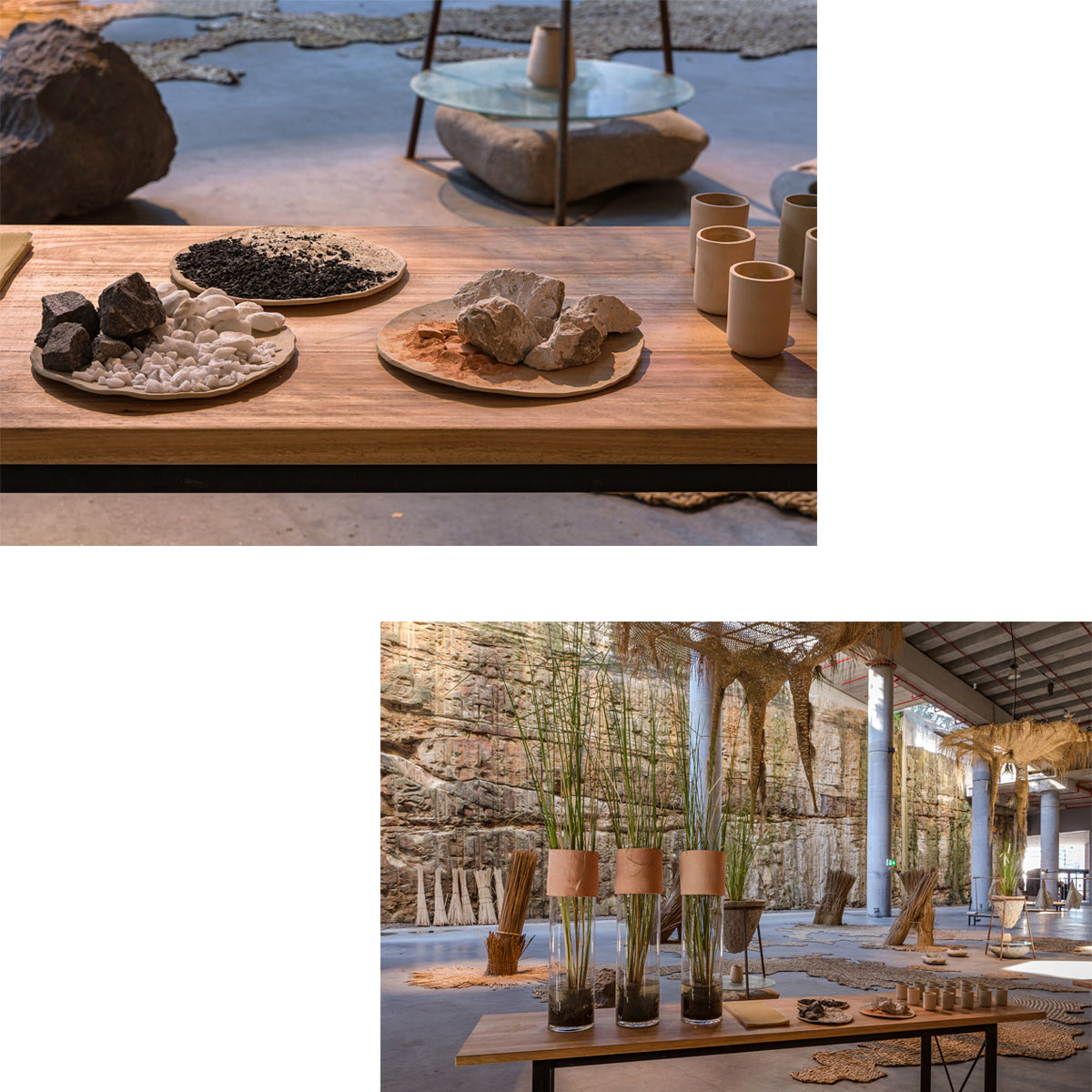
Filtros naturales en Ecosistema del agua. Natural filters in The water ecosystem
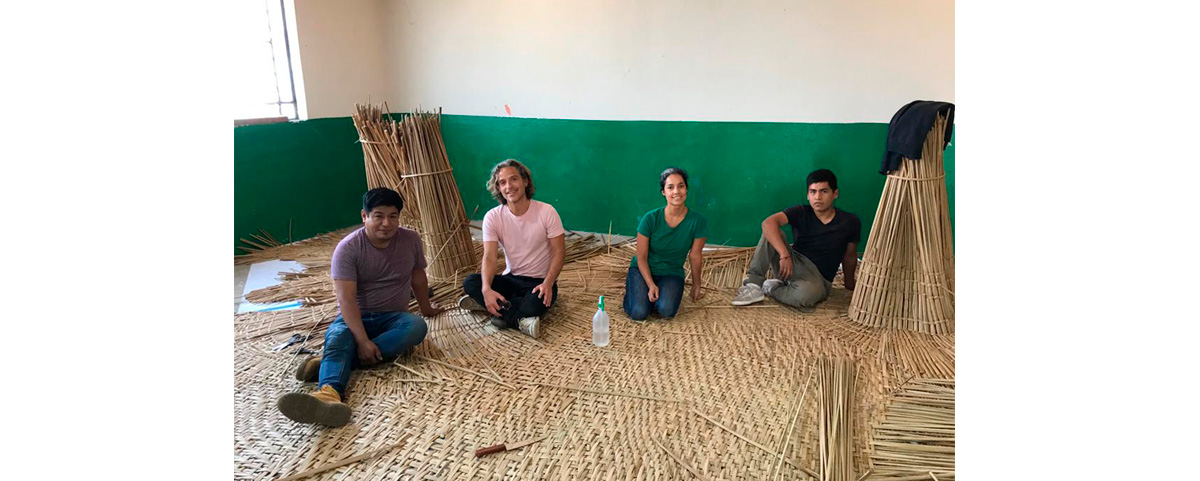
Trabajo en equipo. Team work.
